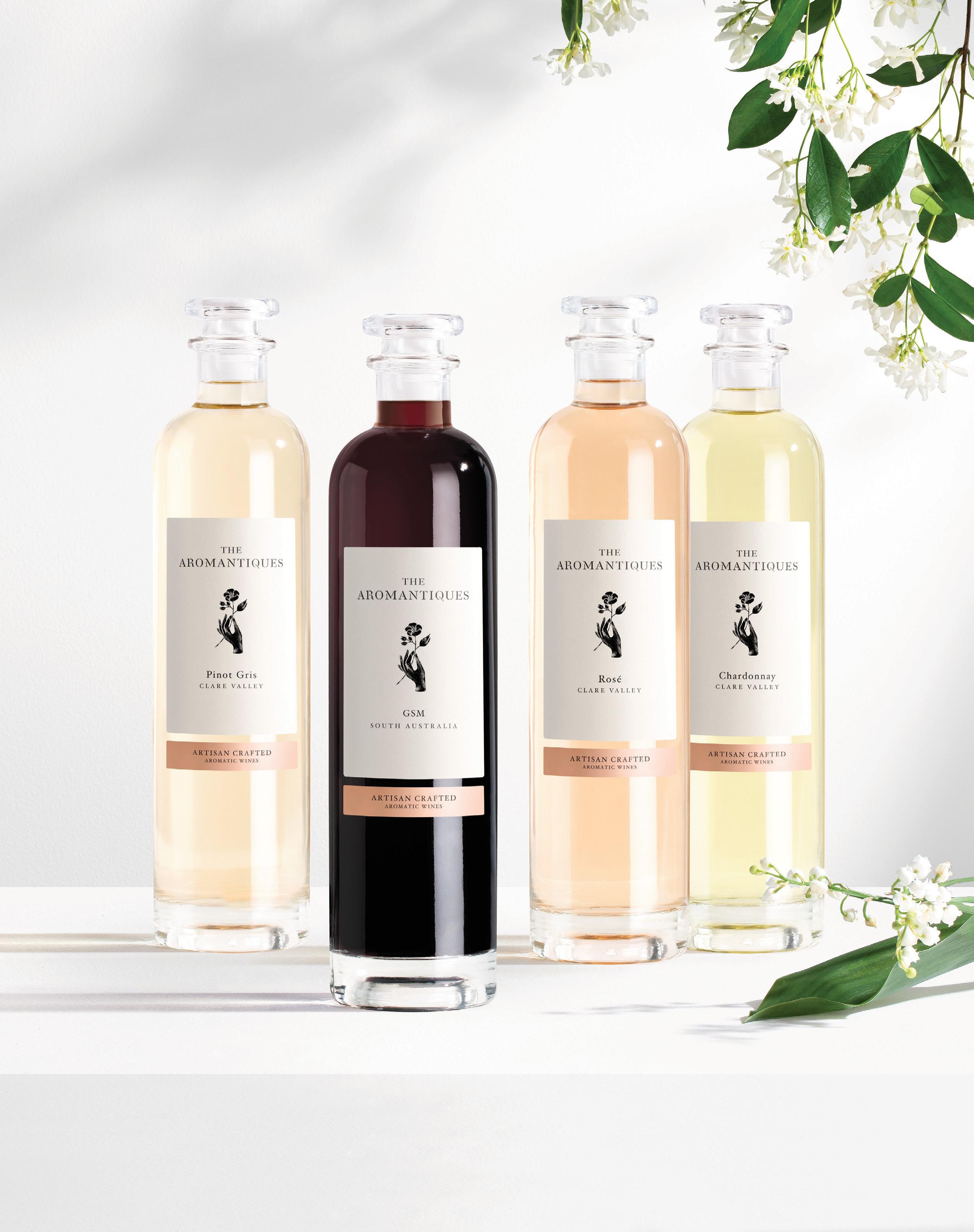










20 Years of Beers
Brewed to celebrate CBCo Brewing’s 20 year anniversary
Easy Drinking
Low bitterness for broad appeal



















Brewed to celebrate CBCo Brewing’s 20 year anniversary
Low bitterness for broad appeal







Welcome to the April issue of National Liquor News, your go-to source for the latest trends, insights, and innovations in Australia’s retail liquor industry.
The ready-to-drink (RTD) category continues to represent an incredibly popular drinks segment, with many brands and new products entering the space. The diverse and growing category is expected to hit US$40b globally by 2027, and while the rate of growth has slowed in recent years, consumers are still being drawn to the category due to its convenience, innovative flavours, and appeal to current drinks trends, which Caoimhe HanrahanLawrence explores beginning on page 38.
In this edition, we also delve into the unique stories and offerings that family-owned wineries bring to the table. As tradition and innovation intertwine, Molly Nicholas discovers how family wineries are finding the balance between preserving heritage and embracing contemporary techniques, beginning on page 44.
And, as we approach the upcoming Mother’s Day celebrations, we have a special feature on ‘What to Stock for Mother’s Day’. This piece provides valuable recommendations and strategies for retailers looking to curate their offerings and cater to this important occasion.
Also in this issue, we were thrilled to be invited along to help Liquor Legends celebrate their
➤ 38 RTDs: Ready to rule
success at the group’s inaugural Strategy Share Session in Brisbane, where John Carmody and Vaughan Peters provided an overview of top-line performance and strategic business objectives.
We were also invited to Perth for the Liquor Stores Association of Western Australia’s annual Sundowner event and members forum. The presence of the Hon. Paul Papalia, Minister for Police, Racing, and Gaming, added a significant dimension to the discussions, highlighting the importance of regulatory frameworks and industry-government collaboration in fostering a thriving and responsible liquor retail sector.
We also share our regular insights from Retail Drinks Australia, DrinkWise, New Zealand Winegrowers, Strikeforce, eLease Lawyers, and Peter Hall provides guidance on staff training. Thank you to all of our contributors.
We hope you enjoy reading this issue as much as we enjoyed putting it together!
Cheers, Deb
Deb Jackson, Managing Editor 02 8586 6156
djackson@intermedia.com.au
➤ 44 Family Wineries: Legacy of the land
➤ 14 Liquor Legends’ inaugural Strategy Share Session
The Intermedia Group takes its Corporate and Social Responsibilities (CSR) seriously and is committed to reducing its impact on the environment. We continuously strive to improve our environmental performance and to initiate additional CSR based
projects and activities.
As part of our company policy we ensure that the products and services used in the manufacture of this magazine are sourced from environmentally responsible suppliers.
This magazine has been printed on paper produced
from
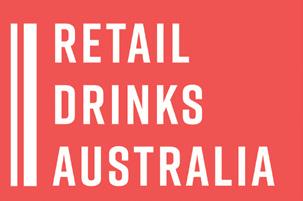






DISCOVER SYMPHONY N o 1, A COMPOSITION OF EXCEPTIONAL TASMANIAN SINGLE MALT WHISKIES. A vibrant, fruity, and harmonious blend, with a hint of vanilla, from the award winning House of Lark.









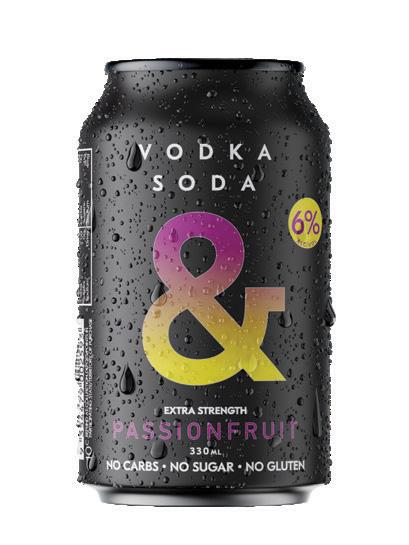

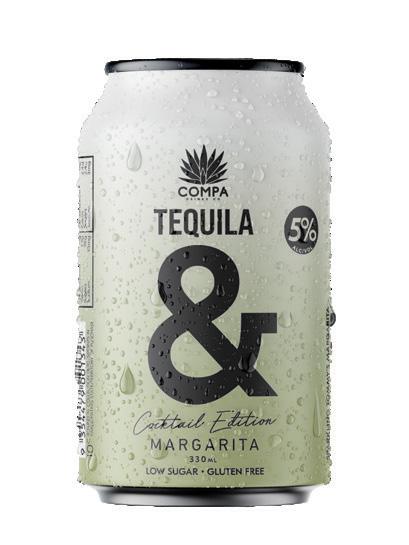



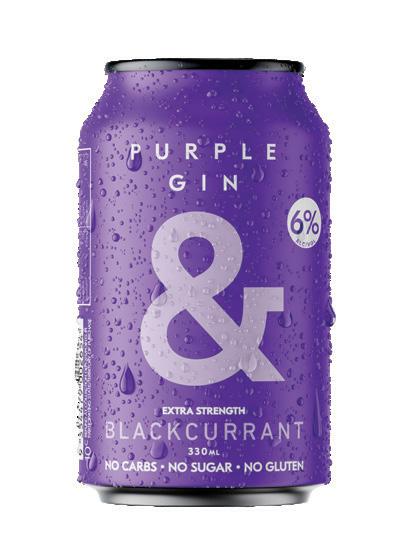



For more information contact your Casella Family Brands representative.
With Sophie Monk as its first Australian ambassador, Yellow Tail explains how authentic and honest partnerships can boost brand popularity.
Much-loved media personality and national icon Sophie Monk has joined forces with Yellow Tail as the brand’s first ever Australian ambassador, aiding the brand’s efforts to grow its breadth of consideration and popularity among consumers. Launching in October last year, Monk’s first campaign focused on helping consumers find their perfect match within the Yellow Tail range. The campaign helped to significantly increase Yellow Tail’s visibility among Australian consumers, further cementing its position as the number one brand in the $6 to $10 price segment in Australia.
Yellow Tail attributes much of this success to Monk’s effective fit with the brand, as she is a genuine fan of the wine. In fact, Monk was the one to initially reach out to Yellow Tail, seeking to work with a brand that she personally supported.
“I’ve been sipping on Yellow Tail Chardonnay and celebrating with Yellow Tail Bubbles for as long as I can remember. As a loyal fan already, I was genuinely thrilled to be invited to officially partner with Yellow Tail, an Aussie brand that epitomises everything I love about life, love, and wine,” Monk said.
In addition, Monk reflects the brand’s ethos of being down-to-earth and straight-talking.
“What I admire most about Yellow Tail is that like me, it’s a brand that doesn’t take itself too seriously. Wine has always been about sharing a few laughs with friends or marking special moments with family – it doesn’t need to be stuffy and complicated, just really delicious,” she added.
Yellow Tail’s growth has outpaced that of

“The key with any brand ambassadorship is authenticity. There is no one who better personifies an iconic Australian brand like Yellow Tail than Sophie Monk. Like our wines, Sophie is fun, down to earth and versatile, and genuinely loves our wines, making her
a great match for our brand.”
Anna Czarnocka, Global Marketing Manager, Yellow Tailits key competitors, and now one in every eight bottles sold within the $6 to $10 price segment is a Yellow Tail.
Anna Czarnocka, Global Marketing Manager, Yellow Tail shared her thoughts on the campaign, saying: “We have received such positive feedback on the
campaign with Sophie Monk from both consumers and retailers. The campaign has had great standout with its bright and engaging creative. The key with any brand ambassadorship is authenticity. There is no one who better personifies an iconic Australian brand like Yellow Tail than Sophie Monk. Like our wines, Sophie is fun, down to earth and versatile, and genuinely loves our wines, making her a great match for our brand.”
Czarnocka explained what draws consumers to the brand.
“For more than 22 years, Yellow Tail has been creating great tasting wine that consistently over delivers on quality and value and can be enjoyed on any occasion. Yellow Tail is an ideal pairing for anyone looking for delicious wine without complexity,” she said.
Get in touch at customerservice@ yellowtail.com.au to discuss expanding your range of Yellow Tail products, and help your customers to find their perfect wine match. ■
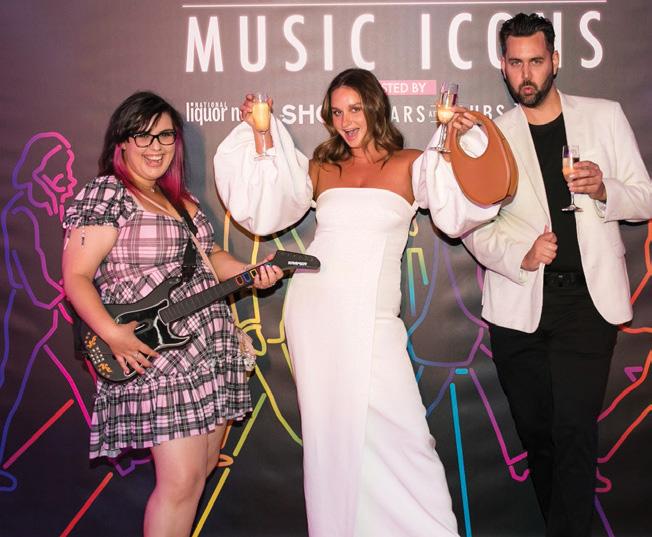
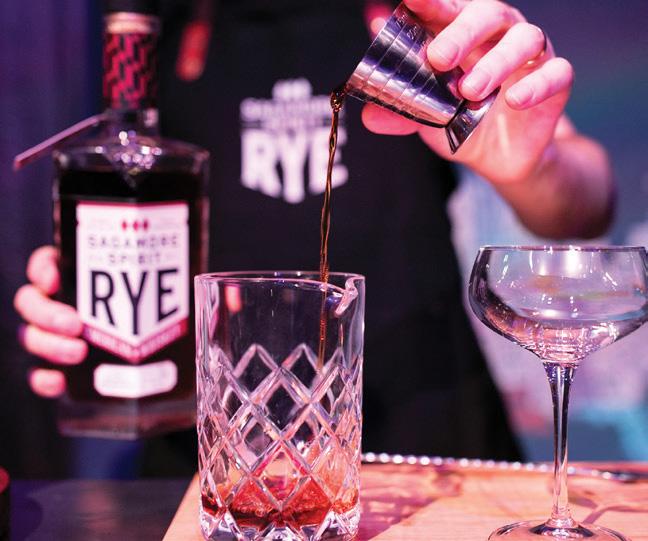




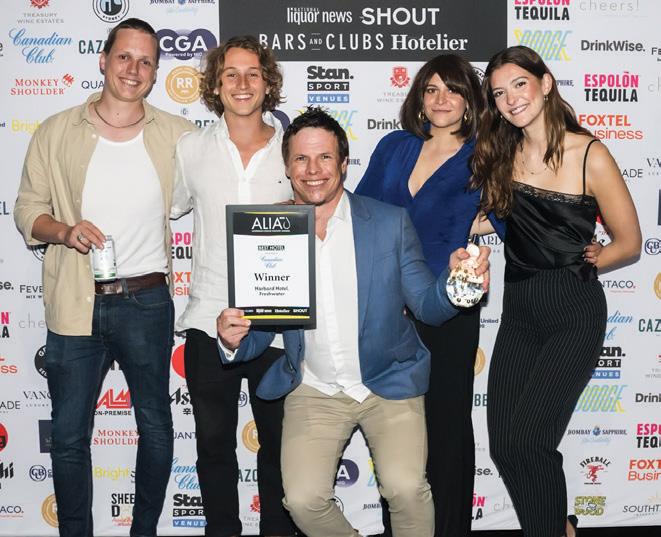
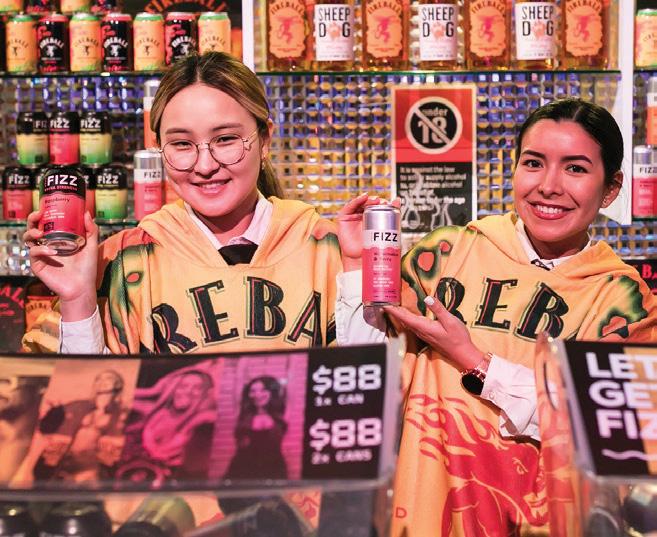
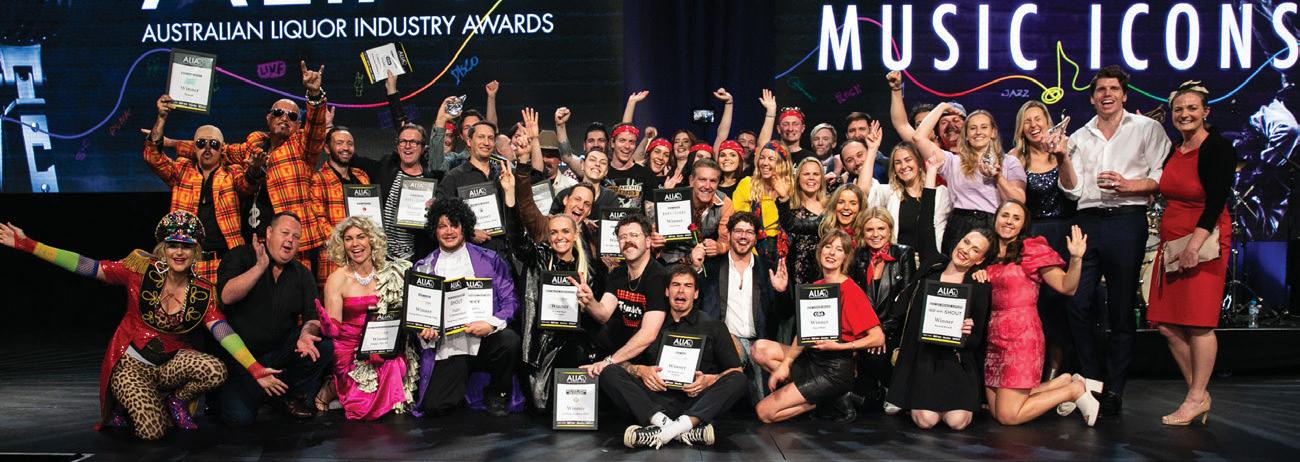



Get your brand in front of 314,000+ trade customers with a sponsorship package
Wednesday 30 October 2024
The Star Event Centre Sydney




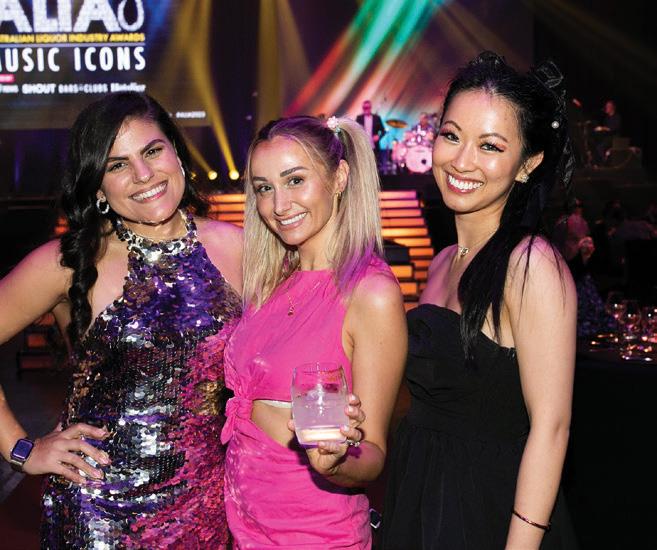


For sponsorship opportunities contact Shane T Williams
stwilliams@intermedia.com.au

Molly Nicholas attended the session in Brisbane, which outlined Liquor Legends’ top-line performance, business developments and the outlook for 2024.

“We don’t want an over-expanding category leaders’ range, we don’t want duplicates in-store, we want to focus on exactly what is going to deliver us the stock turns, sales results and transactions.”
John Carmody Managing DirectorLast month, Liquor Legends held its inaugural Liquor Legends Strategy Share Session at the Emporium Hotel in Brisbane, where the leadership team of the business provided an overview of topline performance and strategic business objectives.
Managing Director John Carmody, alongside National Trade and Marketing Manager Vaughan Peters, touched on everything from category performance and e-commerce to customer lifecycle and consumer loyalty.
In his update, Carmody reported a strong performance with MAT of $232 million worth of purchases, up one per cent, and up three per cent for the month of February.
Although the market is volatile, category-wise, beer continues to dominate overall sales for Liquor Legends, making up 39.9 per cent of total sales, while RTD follows closely behind at 25.6 per cent.
Carmody noted that e-commerce has been a key growth driver for Liquor Legends and its members, making up $6.7 million in sales MAT and drawing an average sale of $154 compared with a normal average sale of $44.
“E-commerce has proven to be a significant additional pantry stock for our venues. We’ve measured it and looked at every key selling period, and we can see the impact that e-commerce is adding to our sales total each time,” he said.
In his update, Carmody expressed his commitment to growing members’ dollars, and highlighted the importance of range efficiency.
“We don’t want an over-expanding category leaders’ range, we don’t want duplicates in-store, we want to focus on exactly what is going to deliver us the stock turns, sales results and transactions.
“Driving transaction is important to this result, and I’m pleased for the team to be presenting the investment that we’ve made in Swordfish, our CRM platform. It has already stepped our game up massively over the last eight months, but what’s to come in the next two will be extraordinary.”
Further to this, Carmody broke down the results of promotional sales.
“We are measuring weekly our promotional effectiveness compared to the same promo periods a year ago. Promo sales represent 40 per cent of our
sales, which ticked up a bit over the last quarter. We’re looking at NPD criteria, what we’re backing and why we’re backing it.”
Over the next 12 months, sustainability will continue to be a priority for Liquor Legends, with the business focusing on environmentally friendly operations, including deployment of electronic shelf labels (ESL), a component that Chief Information Officer Laurence Lo spoke about.
“Liquor Legends built our own interface for ESL systems, so we don’t rely on any third-party system to translate our product database and pricing between the two systems. The benefit to us when we live price update is that it allows us to send updates directly to the ESL,” said Lo.
In Peters’ update, he began by outlining Liquor Legends’ commitment to delivering 12 month plans in advance, including a top-line planning timeline, and more detailed promotional campaigns to ensure seamless collaboration.
Acknowledging the powerhouse that is Liquor Legends Rewards, Peters was happy to announce that rewards and loyalty now carries its own strategic pillar.
Sitting at 894,000 total registered members, Liquor Legends Rewards provides a direct line of communication to the 450,000 members that have authorised SMS communications, 430,000 via email, and 424,000 through both formats.
Speaking about the benefits of the rewards scheme for retailers, which captures valuable first-party data and drives sales through promotional pricing, Peters said: “Members are generating an 80 per cent increase in GDP, sales at 40 per cent, and average transactions are higher.”
Interestingly, Peters shared a closer look at the relationship rewards members have with their points and identified a shift in June 2022 to consumers redeeming points much more frequently.
Reflecting on the strong relationship between earning and redemption, and the onset of economic pressures and subsequent demand for value, Peters said: “The redemption rate is solid, which again really does resonate that the value of our rewards program is not just about the dollars off, but the value on.”
Sharing key information about shopper behaviours
and customer lifecycle journeys, Peters highlighted average spending and buying frequency across generations, and expressed the importance of understanding and nurturing generational behaviours.
“Concerning the customer lifecycle journey, it is important to continually attract, engage and convert shoppers into this journey cycle. We will continue to help members realise the true value of the customer lifecycle into rewards and loyalty, and to accelerate customer retention, revenue and margin growth,” he said.
Circling back to Swordfish, Peters described the CRM program as a critical enabler for smarter, faster and more agile marketing strategies through personalisation and evolving AI capabilities.
“For us to understand the true value of our rewards and loyalty database, the relationship with consumers is becoming much more important, and we want to acknowledge that as best we can because it sets the pathway of our marketing,” Peters concluded. ■

“We will continue to help members realise the true value of the customer lifecycle into rewards and loyalty, and to accelerate customer retention, revenue and margin growth.”
Vaughan Peters National Trade & Marketing ManagerSharing an analysis of the consumer environment, MST Marquee Senior Research Analyst Craig Woolford explained that retail sales growth will be slow in 2024 and liquor channels will see softening of volumes, but he also noted exceptional growth in the RTD category.
Category-wise, RTDs were at the forefront of discussion. Summit Insights Director Cameron Mackie gave an update on Liquor Legends’ Summit software, which provides members and suppliers with shopper behaviour data, and explained that from a subcategory perspective, vodka RTD is the standout performer.
“Back in 2016, 82 per cent of RTDs were dark RTDs, and light RTDs represented 15-16 per cent of RTD revenue. Pre-Covid, we started to see a shift, and that has been continuous over the last five years.
“Dark RTDs are still growing, but not anywhere near as fast as light RTDs, which this year, was up 32 per cent, and we have now have a third of RTD revenue coming from light.”
Further, Mackie explained that the last five years have seen a steady increase in the proportion of light RTD revenue that is coming out of NPD.
“With light RTD, 25 per cent of the sales going into NPD are from shoppers that were already purchasing light RTD, so 75 per cent of dollars going into light RTD NPD is coming from outside the subcategory. It’s bringing in more frequency, more shoppers, and people who used to drink other things.”

The LSA WA members forum gave retailers the opportunity to raise their concerns around the issues that matter most to their business.
The Liquor Stores Association of Western Australia (LSA WA) hosted a successful members’ forum last month in Perth, that gave its retailer members the opportunity to raise concerns directly with Paul Papalia, the Minister for Police; Corrective Services; Racing and Gaming; Defence Industry; and Veterans Issues.
The forum, which ran alongside LSA WA’s annual Sundowner networking event, was a great success with around 100 members in attendance, who were pleased to be given a direct line to speak with the Minister.
The presence of the Hon. Papalia added a significant dimension to the discussions, highlighting the importance of regulatory frameworks and industrygovernment collaboration in fostering a thriving and responsible liquor retail sector.
The main issues raised were around liquor restrictions, licensing concerns, and the ongoing issue
of retail crime, including assaults to staff and theft, which has become a huge expense for retailers who have made the decision to employ security guards to protect their stores and staff.
Minister Papalia listened to the concerns and responded fairly, offering to facilitate the necessary conversations to improve collaboration between licensees and police.
Peter Peck, CEO of LSA WA, said that overall, the forum was a valuable experience for the members in attendance, and they look forward to positive outcomes to the matters that were raised.
“Minister Papalia spoke direct and answered the questions fairly positively each time they were thrown at him, and the feedback I’ve received from the retailers who asked questions, was that it was actually refreshing to get face to face with someone that could make a decision.
“What we’ll do now is we will follow up from those discussions that were raised at the forum with a number of meetings with Minister Papalia and his ministerial staff and will start to put the structure in place to look at rolling out the initiatives that were brought up, including a localised communication network between police and licensees.
“The input from the Small Business Commissioner David Eaton was also really valuable, as he was speaking from an impartial position, being a commissioner, he is not employed by the government, and it basically came together as a really constructive conversation that hopefully will bear some really essential outcomes for our industry, and will improve safety, security, and communication with the government department.” ■
“Minister Papalia spoke direct and answered the questions fairly positively each time they were thrown at him, and the feedback I’ve received from the retailers who asked questions, was that it was actually refreshing to get face to face with someone that could make a decision.”
Peter Peck, CEO, LSA WA


Over the last six months, Western Australia has seen some promising legislative reforms to protect retail workers and address alcohol-related crime.
The Banned Drinkers Register (BDR) has been welcomed by industry as a targeted step to address alcohol-related violence and crime by restricting problem drinkers’ access to takeaway alcohol. Expansions to the BDR came into effect across the Pilbara, Kimberley, Goldfields, Carnarvon and Gascoyne Junction in December 2023, allowing police to register individuals for all alcohol-related offences, not just those in or around licensed premises. In addition, healthcare professionals and social workers can now refer people to the BDR, and penalties have been increased for knowingly supplying alcohol to banned drinkers, with a maximum fine of $10,000.
In February, the WA state government increased harsher penalties for assaults perpetrated against retail workers to a maximum seven years of imprisonment and a fine of $36,000. Those who assault retail workers with a weapon will face up to 10 years in prison.
The Cook government also introduced harsher sentences for repeat retail theft later in the month. Previously, thefts under $1,000 faced a fine-only penalty of $6,000, and a term of imprisonment could not be imposed, regardless of any previous offences. Under the new penalties, repeat offenders who have two or more convictions of theft or attempted theft will no longer be subject to the fine-only penalty, instead facing the higher maximum penalty of two years imprisonment and a fine of $24,000.
However, there have been some propositions that industry leaders deem regressive. Less than a month after changes to the BDR came into effect, WA Liquor Licensing Director Lanie Chopping proposed blanket liquor restrictions in Broome and Derby. Opponents of this proposal argue for targeted responses such as the BDR, rather than whole-of-population restrictions.
In addition, the illegal sale of liquor, or sly grogging, continues to be a concern, especially as it is an avenue for banned drinkers to continue to access alcohol.
Industry is also calling for more wraparound services to help rehabilitate people with alcohol abuse problems and provide support for their families.
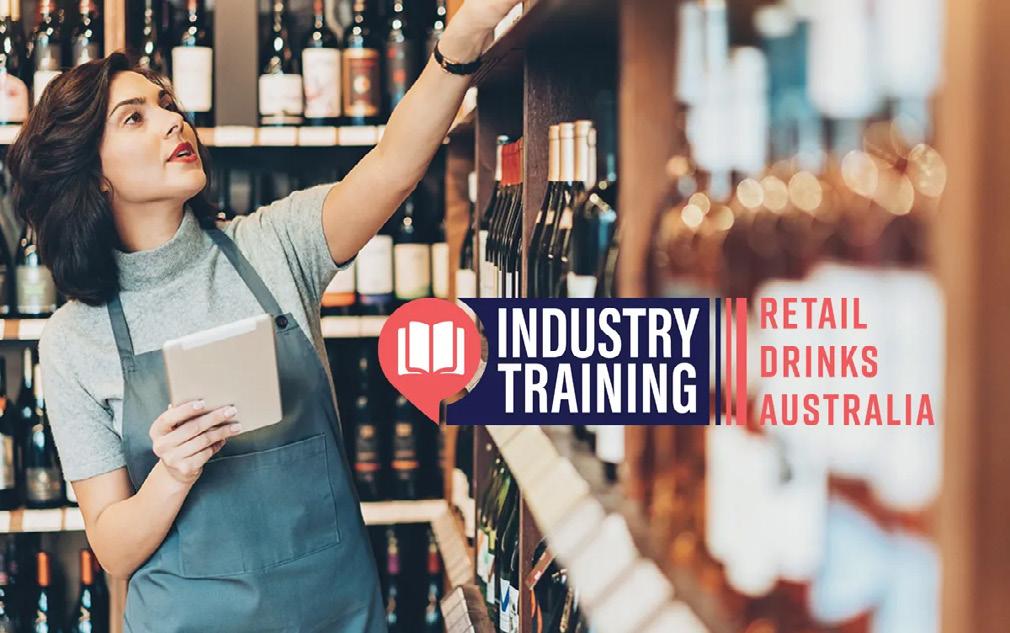
Retail Drinks Australia has launched the online Industry Training Hub, which includes nine non-accredited professional development courses designed to train liquor store owners, managers, and staff in retail fundamentals.
The Training Hub provides support for independent liquor retailers, in recognition that many of them have minimal infrastructure, resources, and training support in their network.
Retail Drinks CEO Michael Waters says: “With a predominantly casual and temporary workforce, and the pressures of operating in the retail liquor landscape constantly evolving, the need to invest in professional development is becoming increasingly important, as a means of retaining staff and fostering building lifelong career paths.”
The Training Hub has been in development for more than a year, with support from industry partners like Urban eLearning and Perreux Consulting. The courses include Business and Strategic Planning, Marketing Principles, Shopper Behaviour, Financial Management, Retail Store Layout, Retail Safety and Security Management, People Management, Negotiation Skills, and Time Management. Each course is two to four hours long and includes a Certificate of Attainment at completion.
The new Industry Training Hub provides Retail Drinks members with access to mandatory industry training such as RSA and Licensee or Approved Manager Training, as well as a broad range of other complementary courses.
“The provision of consistent and reliable training offers people working in our industry a career pathway rather than just a job, and acknowledges that education and training can improve skills, knowledge, and business outcomes,” says Waters.














Shopper Intelligence has found Bottlemart’s catalogues to be best in class across all retail in driving customers to purchase.
Liquor Marketing Group (LMG) launched its brand platform of ‘More in Store’ for Bottlemart and Sip’n Save in September last year, which has seen increased brand awareness, consideration, and advocacy scores for Bottlemart and Sip’n Save.
One of the drivers of shopper engagement and converting this engagement to purchases in-store are Bottlemart’s catalogues, with Shopper Intelligence flagging that more than one-in-four category purchases at Bottlemart are because the shopper saw it in the catalogue pre-store.
Damien Page, LMG General Manager – Merchandise and Marketing, says that catalogues remain a critical element of LMG’s go-to-market plans.
“We know from our own data, and confirmed by Shopper Intelligence, that we win share with each of our catalogues. Importantly, this is a win for our member retailers and our suppliers who support with great products and offers to engage the shopper.
“Catalogues have evolved within Bottlemart and Sip’n Save over many years. It takes more than just product and price as the catalogue is the opportunity to engage with the shopper on experience through offers, range including new products and inspiration to trial along with great products and pricing.”
LMG’s result of 28 per cent shopper recognition of the impact of catalogues surpasses the best performing retailers in other categories, such as Chemist Warehouse (25 per cent) in Pharmacy, and IGA (17 per cent) in Grocery.
Page says: “Catalogues and digital catalogues will be complemented with the launch of loyalty this year and continuation of leading digital marketing engagement,” he says.




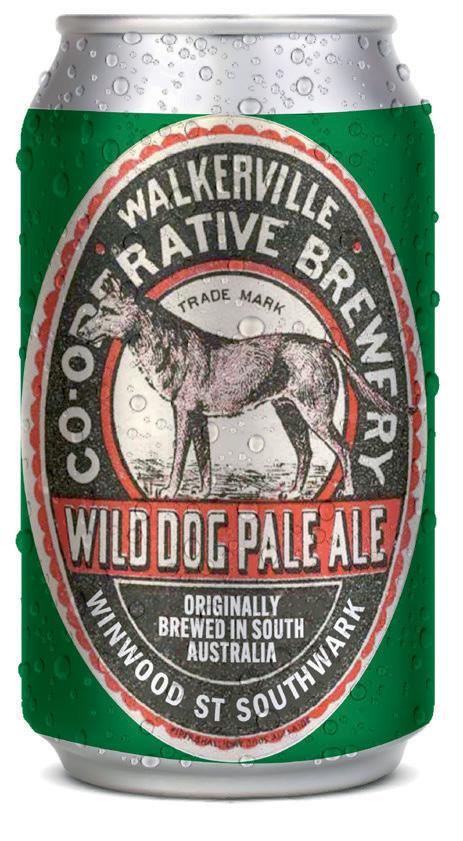

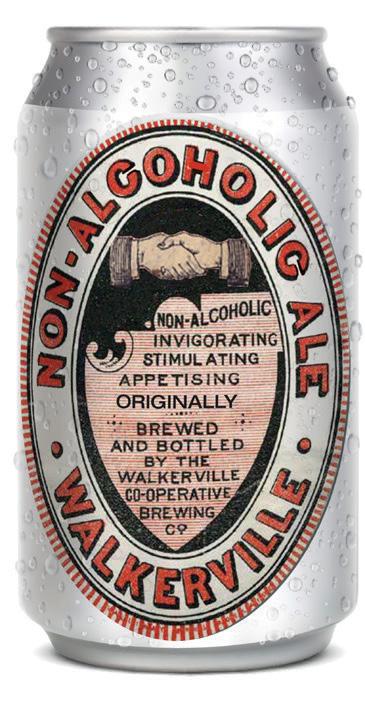
The Brehenys are the most influential family in Australian Brewing History with eighteen different Breheny brewers working in dozens of breweries from 1864 until 2022.
In 1891 ‘Breheny Bros. Breweries’ was established and barrels of tasty ale were made and enjoyed by thirsty drinkers around Australia until the 1930s.
Over one hundred years later descendants of the Breheny brothers found the original family recipe books from the 1920s. From these recipes a range of easy drinking beers are now available to quench the thirst of mainstream beer drinkers across Australia.
Orders can be placed through ALM or Paramount or direct via www.brehenybros.com

The Brehenys are a very influential family in Australian Brewing History with 18 different Breheny brewers working in dozens of breweries across Australia from 1864 until 2022.
In 1891 ‘Breheny Bros. Breweries’ was established, and barrels of tasty ale were made and enjoyed by thirsty drinkers around Australia until the 1930s.
More than 100 years later, descendants of the Breheny brothers found the original family recipe books from the 1920s. From these recipes a range of easy drinking beers are now available to quench the thirst of mainstream beer drinkers across Australia.
Breheny Brothers beers include Royal Lager, Queensland Mid and gold medal winning, Superior Stout, which are available in 355mL cans and 50L kegs.
Distributor: ALM and Paramount
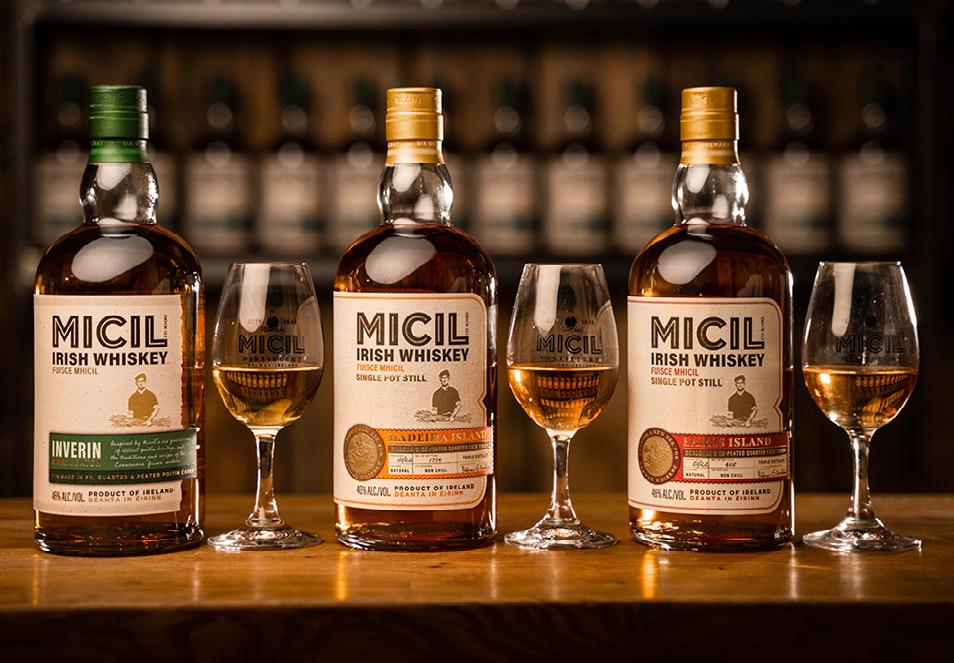
Premium spirits specialist JQWS is expanding its offering with the addition of two new brands, Micil and Zymurgorium, to its distribution portfolio in Australia.
Situated in Ireland, Micil Distillery is steeped in 170 years of refined tradition, with its whiskey crafted in small pot stills on the shores of Galway Bay from generations-old recipes, using nothing more than grain, water and yeast.
“Micil is reviving and uniting the Connemara and Galway distilling traditions and exploring the boundaries of traditional Irish whiskey-making to create a diverse flavour and distinct character,” says JQWS General Manager Josh Blake.
Zymurgorium’s portfolio comprises an Original Manchester Gin and several flavoured gins, with the whole range showcasing an abundance of ingredients and flavours, crafted from unique brewing and distilling styles.
“Innovation is at the heart of Zymurgorium, and it brings something new and exciting to JQWS for the Australian market to savour,” Blake added.
Distributor: JQWS
Primarily known for its popular RTDs, Ampersand Projects also produces Vodka & 500mL. The vodka is charcoal filtered for a super smooth spirit with virtually no burn, which fans of Ampersand Projects’ Vodka & Soda range already appreciate. As with all Ampersand Projects products, Vodka & 500mL is Australian made.
Convenience is a priority for Ampersand Projects’ RTD range, and this is still true of Vodka & 500mL, as Alex Bottomley, co-Founder and Director, Ampersand Projects, explained.
“We introduced this pack format as we realised that drinkers were looking for a local vodka product that offered the convenience of the 500mL size. The larger formats were too much liquid and Vodka & 500mL was the perfect size for the millennial going to an event or gathering,” he said.
Vodka & 500mL represents a premium offering within the range of Ampersand Projects products, but still maintains a competitive price point, with an RRP of $37.
Distributor: ALM, ILG, Liquid Mix
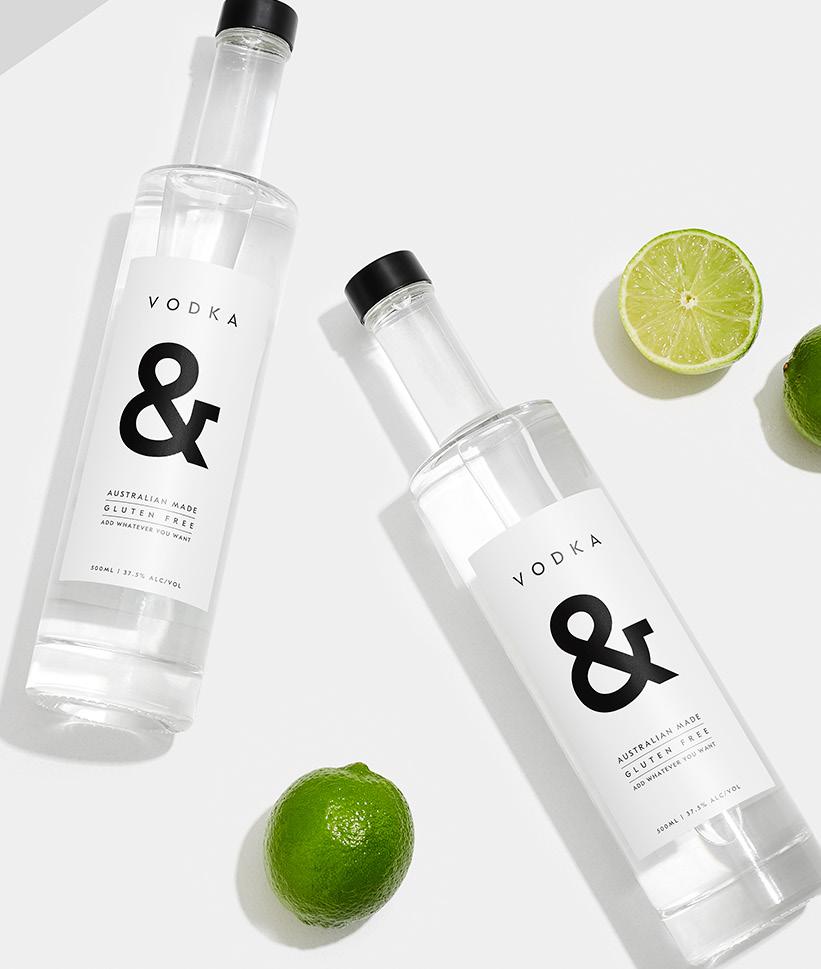
Made with the Portuguese grape variety Touriga Nacional, the Nugan Estate Single Vineyard Riverina Carver Touriga 2023 is produced from grapes grown on the banks of the Murrumbidgee River in the Riverina, which is the largest wine producing region in New South Wales.
The wine is matured for six months in French oak barrels to provide softness, nuance and texture, resulting in a full-bodied wine that is dark cherry in colour with bright hues, with aromas of cherry, plum, floral notes of violet and hints of white pepper.
At a retail price of $27.95, the Carver Vineyard Touriga 2023 is Vegan Australia Certified and sits at an ABV of 14 per cent.
Distributor: Nugan Estate


Goldy Lager is the latest beer to come from CBCo Brewing, as well as the first release in the brewery’s 20th year of operation. The release celebrates CBCo Brewing’s long-running dedication to independent brewing and reflects the expertise the brewery has developed over its 20 years of operation.
Lawrence Dowd, Managing Director, CBCo Brewing, is enthusiastic about the release and the 20-year milestone brew.
“We couldn’t be more excited to introduce Goldy Lager to our core range. Goldy is an easy-drinking lager, perfect for the sunny days and those golden moments when you get to kick back, relax, and enjoy life’s simple pleasures,” he said.
With low bitterness and a four per cent ABV, Goldy Lager is a refreshing Australian Lager that will appeal to a broad audience. In addition, its striking gold can will make it stand out on shelves.
“Goldy Lager is not just a beer; it is a celebration of CBCo Brewing’s 20 years of brewing expertise. With every sip of Goldy Lager, you are experiencing the smooth crisp taste crafted by over two decades of hard work, dedication, passion and innovation,” Dowd said.
Distributor: Paramount Liquor, ALM, Direct
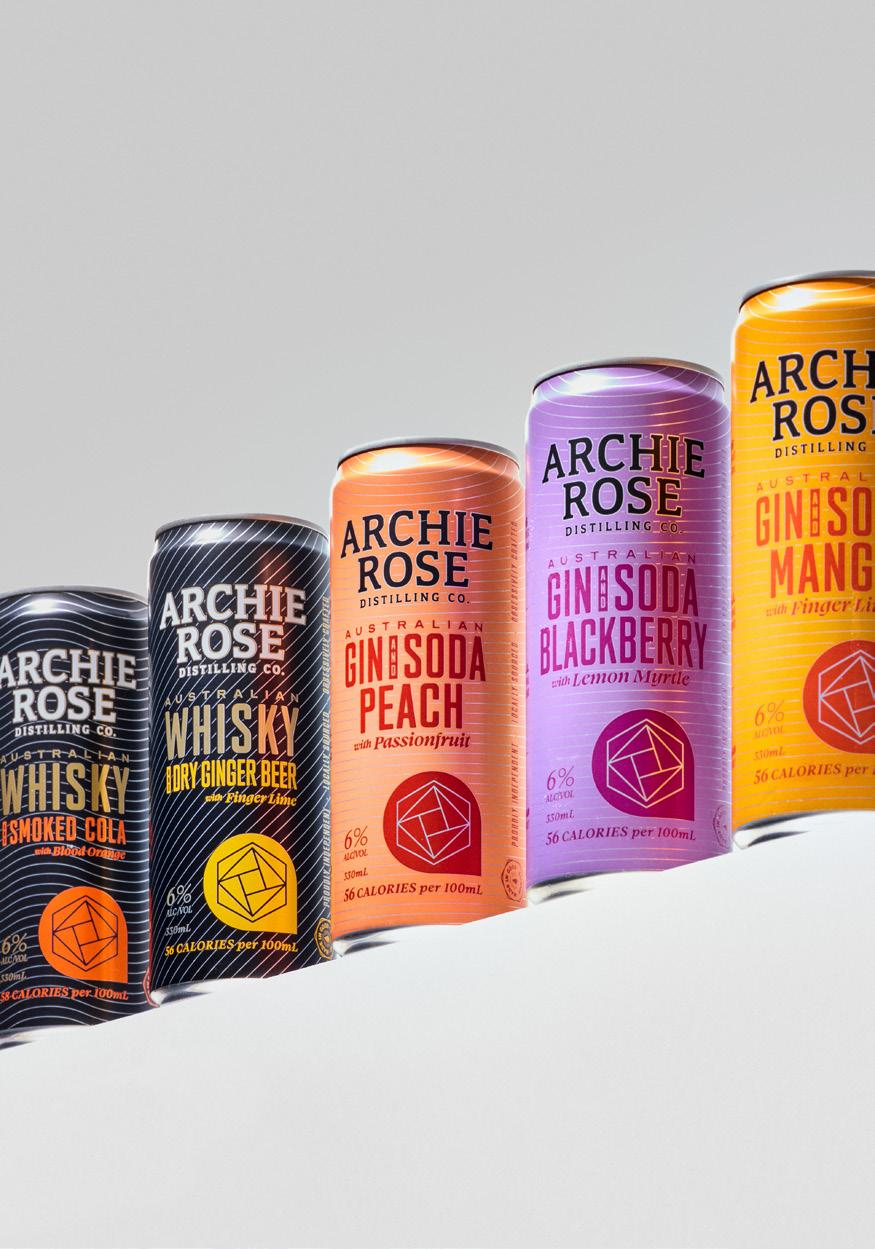
The Archie Rose Fundamental Spirits family has gained five new premix cans. The entire range is made with Archie Rose Australian Gin and Whisky, now updated to a 330mL format and six per cent ABV.
The three new gin premix cans include: Gin & Peach Soda with Passionfruit, Gin & Blackberry with Native Lemon Myrtle and Gin & Mango with Native Finger Lime.
All three flavours feature Archie Rose Straight Dry Gin as a base and are cold-distilled with local and reclaimed botanicals.
The two new whisky premix cans include: Whisky with Smoked Cola & Blood Orange and Whisky with Dry Ginger Beer & Native Finger Lime.
Both have been crafted with Archie Rose Double Malt Whisky, featuring 100 per cent locally sourced Australian malts.
Archie Rose has never been one to rest on its laurels, always exploring, innovating and evolving its offering to bring the highest quality Australian spirits and ingredients to as many people as possible. The team is excited to now be even more equipped to do so through the Fundamental Spirits Range.
Distributor: Available via all good wholesalers
Coopers has put a floral twist on an old favourite with the release of its new Coopers Botanic Ale, which enhances its classic Coopers Sparkling Ale with the addition of juniper.
A strong category crossover exists among gin and craft beer drinkers, and with 30 per cent of consumers buying across both categories
Coopers hopes the new beer will appeal to gin lovers and craft beer drinkers alike.
Coopers Brewery General Manager Michael Shearer says the brewers went for something different with this limited release.
“Coopers Botanical Ale draws on our 19th century Sparkling Ale recipe while combining novel elements such as juniper sourced from the UK, and Nectaron hops, which are a trending variety from New Zealand,” he said.
“The result is a tasty and unique addition to Australia’s craft beer category that we know will appeal to existing and new drinkers of Coopers. This is a very limited release, so you’ll need to get in early before stock runs out.”
The beer has fruity and floral hop aromas enhanced by the infusion of juniper, a full-bodied palate and crisp finishing bitterness at an ABV of 5.8 per cent, complemented by a standout can design that takes inspiration from the 60s.
Distributor: See website for wholesalers


De Bortoli Wines is following the success of its award-winning Rosé Rosé and Blue Gris with the launch of Pinot Pinot Noir, which the winery describes as a “natural progression” after the success of the two earlier wines.
A De Bortoli spokesperson said: “Leveraging De Bortoli Wines’ renowned expertise in Pinot Noir, the introduction of Pinot Pinot Noir is a natural progression, building upon the popularity of its predecessors.
“For those seeking an easy drinking red wine, Pinot Pinot Noir stands as a quietly confident choice. A wine that adapts effortlessly to any occasion and weather, the heart of Pinot Pinot Noir lies in its super perfumed notes of pomegranate, damson plum, and forest fruits.
“Boasting crunchy red fruits and an all-round snappy flavour, this red wine exudes purity in spades with flavours that dance on your palate. For an unforgettable pairing, we recommend trying it with a succulent duck dish.”
The wine is available now for independent retailers through De Bortoli Wines, with a $19.95 RRP.
Distributor: De Bortoli Wines
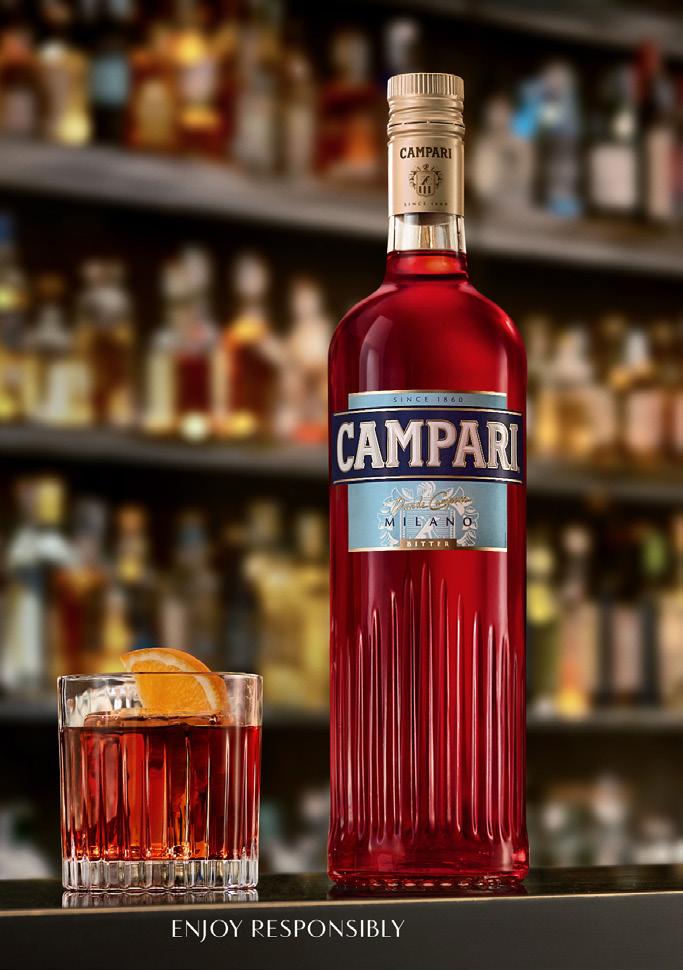
Campari has released a new bottle design inspired by its hometown of Milano, one of the world’s foremost fashion and design capitals.
The modern and minimalist design draws the eye to the city’s name in the centre of the bottle with tapered grooves cut into the glass. The lines also symbolise Campari’s journey from Milano to the rest of the world.
Paolo Marinoni, Marketing Director of Campari
Australia, said: “Since its creation, the Campari bottle has evolved alongside Milano, continuously drawing inspiration from its resourcefulness and its excitement, traits we feel are deeply bound to the spirit of our brand. We wanted to continue to pay homage to Milano through the design of the new Campari bottle and we could not be happier with the story it tells.”
The new bottle design was launched at the 24th Biennale of Sydney at White Bay Power Station, with Campari also marking its third year as partner to the event.
Distributor: Campari
Following the successful Australian debut of Kirin Hyoketsu Lemon last year, the Japanese RTD brand has released Peach and Pineapple.
These new flavours use the same proprietary Hyoten Toketsu technology as the lemon flavour, wherein the freshly squeezed peach and pineapple juice is flash frozen and mixed with vodka and soda. The resulting RTD has an ABV of six per cent with 0.7g of sugar and 116 calories.
Penni Terrey, Brand Director RTD at Lion, said: “The success of our Lemon flavour in Australia has motivated us to continue delivering innovative and refreshing ready-to-drink beverages. We believe these new additions will further enhance the Kirin Hyoketsu experience in Australia, building on our promise of an intense natural fruit flavour without any lingering aftertaste.”
Kirin Hyoketsu Peach is available now, and Kirin Hyoketsu Pineapple will be available from late-April.
Distributor: Lion

Beachtree Distilling Co. was awarded World’s Best Craft Producer at this year’s Icons of Gin awards, only a month after its Organic Tiger Quoll Vodka won Australia’s Best Varietal Vodka at the World Vodka Awards.
Head Distiller Steve Grace was humbled by the win, saying: “This recognition on such a prestigious platform is a dream come true and a testament to the collective dedication, creativity, and unwavering commitment our team shares.
“We pour our hearts into every bottle, meticulously crafting gins using the finest Australian botanicals, and this recognition fuels our drive to push boundaries and share our love for gin with the world,” he said.
Beachtree Distilling Co. is a First Nations Certified Distillery, founded by Kirra Daley as a way to share the unique flavours of Australian botanicals.
“Every sip is an exploration of the Australian landscape, offering a taste of our land’s rich heritage and embodying our commitment to sustainability and partnership with local farmers and growers. The colourful and creative gin bottles also showcase the distillery’s Indigenous heritage and sustainable values,” Daley said.
Distributor: Paramount, Direct
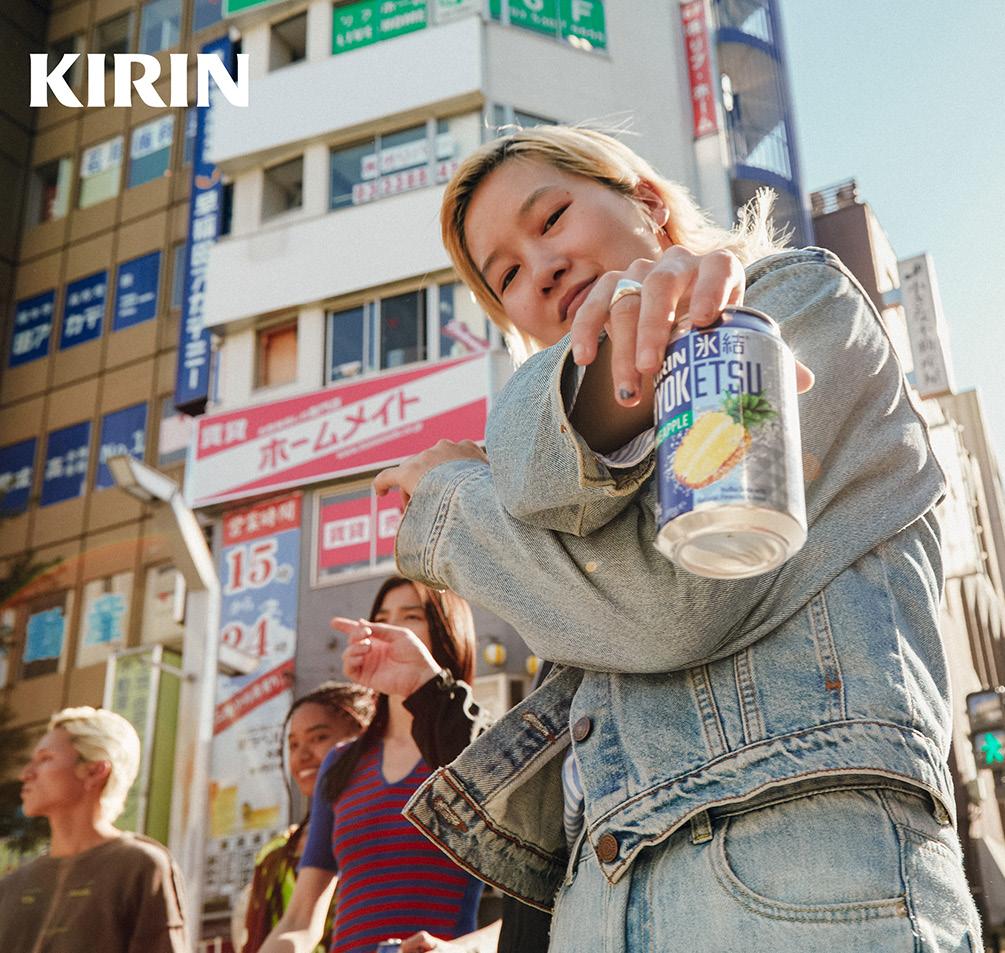
Lark was named Australia’s Best across two categories at this year’s World Whiskies Awards, a first for the Tasmanian distillery. Best Australian Single Malt Whisky went to Lark Fresh IPA Cask Single Malt Whisky, a collaboration with Garage Project brewery, which was in high demand and has now sold out.
For the third year in a row, Lark Symphony No. 1 was crowned Best Australian Blended Malt Whisky. A blend of Tasmanian whiskies aged in American oak, sherry, and port casks, tasting notes describe a luscious and fruity nose with a palate of fresh mango, toasted pineapple and vanilla.



Forget the flowers and get mum Rosé over roses. Yellow Bubbles Rosé is light, effervescent and refreshing, with notes of strawberries and red cherry with a hint of lemon. The palate is soft and creamy, making this wine a seamless match for any celebration. Bubbles
Rosé pairs perfectly with fresh salads, your favourite dessert or would be great served alongside a Mother’s Day brunch of French toast and berries.
Pretty in pink, this bottle is also a brilliant last minute gift idea for mum.
Distributor: Casella Family Brands

The Aromantiques is a captivating new collection of premium Australian wines, each lovingly crafted to express vibrant, enticing aromas and purity of flavour.
Designed to connect with and excite contemporary wine drinkers by tapping into lifestyle associations and drawing upon cues from spirits, beauty and luxury, The Aromantiques delivers refreshment, style and a sensory experience.
Researched by women and designed by women, The Aromantiques is a new brand with elegance and finesse both inside and outside the bottle.
Tapping into high growth varietals in the premium price segment, the range launches with a Chardonnay, Pinot Gris, Rose and GSM (RRP $30).
Distributor: Taylors

“Mother’s
Day presents a great opportunity for liquor retailers as although it is a nationwide event, the way everyone chooses to celebrate Mother’s Day differs. Many people will choose to have a brunch, which pairs perfectly with a sparkling, some may indulge in a long lunch with a vibrant Pinot Grigio or bold Shiraz and others a family picnic where smaller format products like piccolos are perfect. It is a brilliant time to showcase a wider variety of drinks and formats and tap into products that are great for that gifting opportunity.”
Mark Churi, National Sales Manager, Casella Family BrandsGive mum a ‘true taste of the Margaret River’ this Mother’s Day with either the Australian Native Gin or Indian Ocean Gin from Giniversity.
The South West of Western Australia conjures images of majestic forests, striking coastline and, of course, picturesque rows of perfectly planted grape vines. The area is one of 34 biodiversity hotspots in the World. It’s these stunning natural surroundings that inspired these Giniversity expressions, which all reflect the amazing flavours of the Margaret River.
Australian Native Gin is prepared using native Geraldton wax, lemon myrtle and the unique Australian fruit, emu plum. Named for the emu’s penchant to seek out this rare indigo fruit across extreme distances, emu plum provides this gin with earthy undertones, which is complemented by the lemongrass notes of the Geraldton wax.
Indian Ocean Gin magically fuses unique West Australian botanicals of Salt Bush and Geraldton Wax diluted with drops of salty Gnarabup sea water then melded Juniper, Samphire, Summer Berries, Sweet Orange and Butterfly Pea to create the natural deep blue hue of the Indian Ocean.
Distributor: Contact paul.burke@distillery.com.au or phone 0456 774 245

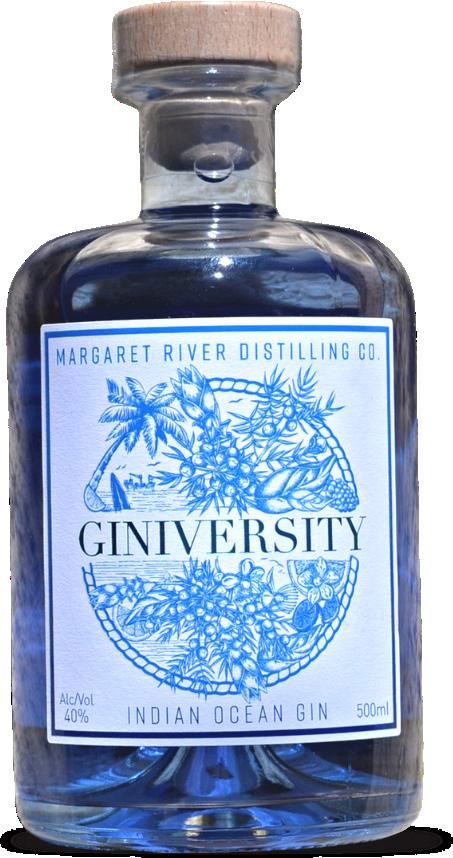

Prosecco is the latest addition to Calabria’s Bélena range
Calabria Family Wines is extending its popular Bélena wine range, with the addition of Prosecco.
Elizabeth Calabria-Staltare, Head of Marketing at Calabria Family Wine Group, says: “We are excited to be expanding the Bélena wine collection, entering into the thriving Prosecco category with an easy drinking Prosecco that will attract those looking for a more affordable sparkling alternative.”
To support the launch, Calabria Family Wines have joined forces with the esteemed Portobello PR, who will be championing the Bélena wine range with a series of activations this Mother’s Day.
Distributor: Calabria Family Wine Group
Mother’s Day

Gifting a bottle of Brown Brothers Prosecco NV is the perfect way to celebrate the special women in your life whether it’s your mum, nanna, sister, or a friend.
Its zesty, crisp flavours and delicate bubbles pair well with everything from sweet treats and salty snacks to fresh seafood, fruit, and desserts.
Brown Brothers Prosecco is vibrant and easy drinking, a refreshing expression of Prosecco that’s rich in citrus notes with a soft, bubbly palate displaying apple and pear characters. This refreshing sparkling wine is best enjoyed while young and fresh.
Elevate any occasion and take the guess work out of gifting this year. Brown Brothers Prosecco makes every moment, big or small, something to celebrate whether relaxing at home or sharing with loved ones.
Distributor: Brown Family Wine Group

This fresh, rose petal gin was first made to honour Glendalough’s Head Distiller’s mum, Rose, at his youngest brother’s wedding. She had recently passed, so he distilled fresh flowers from her rose garden into a batch of the Wild Irish Botanical Gin so that she could be there in spirit.
To make this special, small batch Gin the team completely rebalanced their Gin recipe and redistilled it with extra fruit, flowers, spices and, of course, a lot of fresh rose petals. Two varieties of rose are used: the rare and elusive Wild Rose from the Wicklow mountains and the large, fragrant Heritage Rose. They come together to make this light, floral and flavoursome gin. Given the delicate ingredients, it is distilled even slower and more gently than Glendalough’s dry Gin with vapor distillation playing a bigger part extracting those essential oils and flavours. After distillation, it is further infused with even more roses to deepen the flavours and impart a lovely pink hue.
Best enjoyed as a spritz, with 45mL poured into an ice-filled glass, topped with pink grapefruit soda and garnished with fresh grapefruit and a sprig mint.
Distributor: Vanguard Luxury Brands
“Mums are special, and they deserve the best. Nobody wants to roll up to lunch with something mediocre under their arm, but they’re almost certainly completely disorganised and running into your store on the way to the celebration. Make it simple for shoppers to elevate the occasion (and impress Mum) with step-up options in the main traffic areas. Something with a little bit of a story that can be relayed at the lunch table won’t hurt…”
Ryan Anderson, Marketing Manager, Vanguard Luxury Brands

For comprehensive category buyer’s guides, subscribe to the National Liquor News e-newsletter

To submit products and view the 2024 trade buyer’s guide schedule, please contact:
Shane T Williams stwilliams@intermedia.com.au

BrightSide Executive Search is the only dedicated drinks recruitment specialist nationally and has been a trusted advisor to the industry for well over a decade. Through accessing its wide-reaching network of potential candidates, BrightSide takes the hassle out of recruitment for drinks businesses, advising how they can stay nimble and competitive in a tight market to attract the absolute right person for each role. The latest BrightSide success stories below show the strong abilities of the recruitment agency in partnership with drinks businesses of all sizes, country-wide.

Joining Casella
Family Brands as NBM Endeavour, Steven Leet brings extensive experience in delivering profit and brand growth.

Michael Colaneri has joined Twelve Bottles as an experienced Account Manager driving brand growth in the Melbourne market.

Proximo welcomes Vladimir Krstic who has a wealth of industry experience to its NSW team, as Category Manager Sydney.


Trifon Estate is enjoying the extensive wine expertise Ben Tanner brings to the team as National Sales Manager.

Giant Steps is thrilled with Robin Ter-Elst joining as Hospitality Manager for its newly refurbished cellar door and D2C sales. Proximo welcomed Mattia Balido who has a strong background in hospitality as Area Sales Manager On-Premise in Perth.

Fever-Tree is loving the energy, passion, and experience Tessa Lockwood brings to the team as Brand Manager Sydney.

Matt Castle brings a huge amount of retail and trade experience to his new role as ASM On-Premise Specialist Melbourne with Proximo.

Blythe Whittle is enjoying sharing her extensive customer marketing IP in her new Trade Marketing Executive role with Proximo Sydney.

HOFW has welcomed Jonathan Belanger to the team as Customer Manager in Victoria utilising his passion for the wine industry.
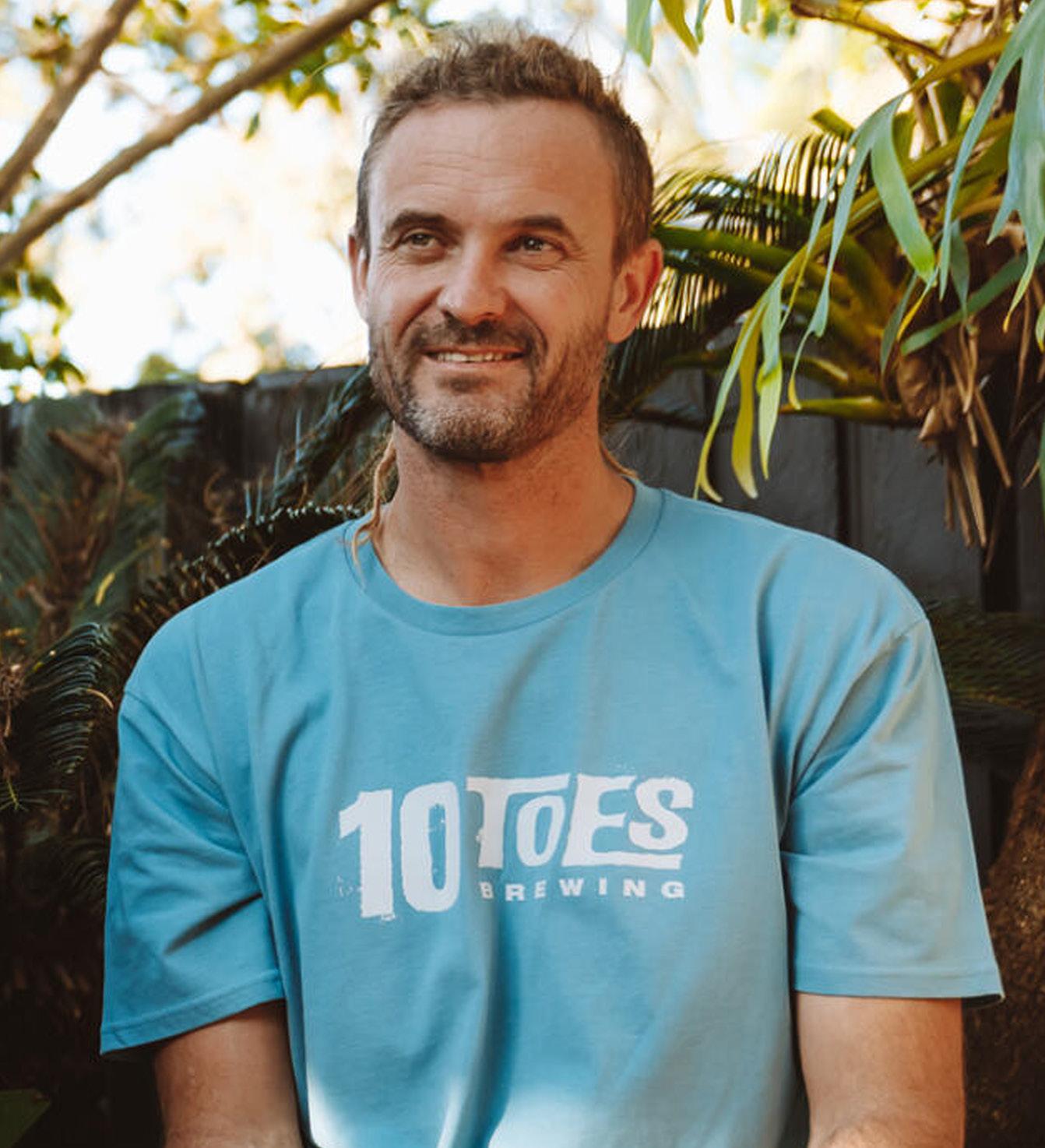
The year has begun well for Sunshine Coast’s 10 Toes Brewery, which reached its highest GABS ranking of 18 after several years on the list ; National Liquor News spoke to Head Brewer Rupert Hall about how he continues to grow and improve the brewery.
Hall began his journey in the industry 25 years ago, when he began home distilling and brewing while studying chemical engineering at university. He originally focused on home distilling, but it was brewing that brought him the most joy.
“Those first few batches blew my mind with the freshness of flavour and the clean bowl profile coming through. I never looked back, and it went from a hobby to an obsession, and now it’s a career,” he said.
As his career progresses, Hall is focusing on different aspects of the brewing process and is enjoying bringing his engineering knowledge into his craft.
“When I was hands-on in the brewery myself, I had a passion for the ingredients, for new and interesting flavours. Now that I’m a business owner, I love process control and process improvements. I’m a strong believer that beer is five per cent recipe
and 95 per cent process. I get to apply my engineering background in process chemical engineering into the brewing industry. That’s where my passion is these days,” he said.
Hall was surprised by the GABS ranking this year but attributes it to the community’s support for 10 Toes brewery.
“I’m not a big believer in traditional marketing or making a lot of noise. Within the Sunshine Coast, we’ve been adopted by the community. We’ve got that strong community connection. We’ve never done major advertising for GABS, other than Instagram posts.
“We’re a little bit blown away by the results this year. It’s just amazing to see the support that we’ve been getting, particularly given our distribution is relatively small compared to a lot of the players you see in the top 100,” he said.
In addition, 10 Toes won Best Artistic Beer Label at the Queensland Royal Beer Awards for its Culture Kick Margarita Lime Gose. The label was the work of 10 Toes’ inhouse graphic designer Gerard King.
“Gerard is a quirky guy that can just convert what’s in his head onto paper.
We’ve tried to position our artwork around urban alley graffiti, an urban alley with the last 10 years of different artists overlaying their little pieces together. You end up with this collage of a history of different art styles and forms. We try to keep all our art a little bit playful and a little bit quirky. We always strive towards not taking life too seriously. Hats off to Gerard, he does a lot of great work,” Hall said.
This ethos of ‘not taking life too seriously’ is what has fostered the community around 10 Toes Brewing.
“One thing that really resonates with us is leaving your title at the door. The 10 Toes name came about from a mixture of surf culture, just keeping life simple. When you paddle out behind the breakers and you’re sitting there on your board, the guy next to you could be anyone. He could be a lawyer or a tradie. You leave your title at the beach,” Hall said. “That’s what we have seen as we go into the brewery. There’s a conversation, it’s a community. The people who are gravitating to and operating our venues, you couldn’t pick their walk of life. There isn’t any one demographic that we’re aiming at.” ■
10 Toes’ Rupert Hall discusses his successful 25-year career and how the brewery builds community support.In early March, Michael Waters, the CEO of Retail Drinks Australia was invited to present at the 2024 Australasian Liquor Licensing Authorities Forum.
 Michael Waters Chief Executive Officer Retail Drinks Australia
Michael Waters Chief Executive Officer Retail Drinks Australia

The Australasian Liquor Licensing Authorities Forum (ALLAF) is a two-day conference held in a different Australian city each year, where major liquor regulators from every state and territory attend to discuss emerging issues affecting liquor regulation. This marked the first time Retail Drinks has presented since the 2019 ALLAF in Hobart.
Our recent presentation focused on the online alcohol sale and delivery sector and our major initiatives in this space, including the Online Code of Conduct and Online Alcohol Sale and Delivery Research Project. The presentation covered the Code extensively and its evolution over the past five years, including the twoyear review processes held in 2021 and 2023. Statistics regarding the Code’s mystery shop program were also provided, including that around 25,000 mystery shops had been completed across the country since January 2020. Regulators were informed of the specific processes undertaken to identify Code breaches and how we engage directly with all stakeholders involved to address any instances of non-compliance.
The presentation also included the most up-todate information regarding the dynamics of the sector as uncovered by the Frontier Economics report published in July last year. This included key facts such as the value of the online alcohol sales market and its projected growth over the coming years. Key misconceptions regarding the sector were addressed, including that online alcohol deliveries
increase alcohol accessibility for minors and that alcohol deliveries are used to extend existing drinking sessions. The need for a two-hour minimum delay in the same-day delivery space as suggested by some stakeholders was also thoroughly rejected. As was the case when the report was first released, regulators expressed great interest in the report and its findings and the implications for the sector.
In addition to Retail Drinks’ major initiatives in the online space, our ALLAF presentation covered off on major regulatory challenges to be confronted by regulators over the coming years. This included emerging technology advancements, the evolution in online payments methods, and issues related to driver safety, to name a few. The regulators present asked a number of questions about how Retail Drinks was responding to these individual challenges and ways in which positive policy outcomes could be best achieved in the future.
Retail Drinks was proud to have been given the opportunity to present at this year’s ALLAF conference and looks forward to further engagement with all state and territory government regulators on online alcohol sales and deliveries in the coming months, particularly with several regulatory reviews either in the process of occurring, or close to having been completed. Our presentation to ALLAF is just the latest aspect of our ongoing relationships with governments across the country as a close and trusted advisor. ■

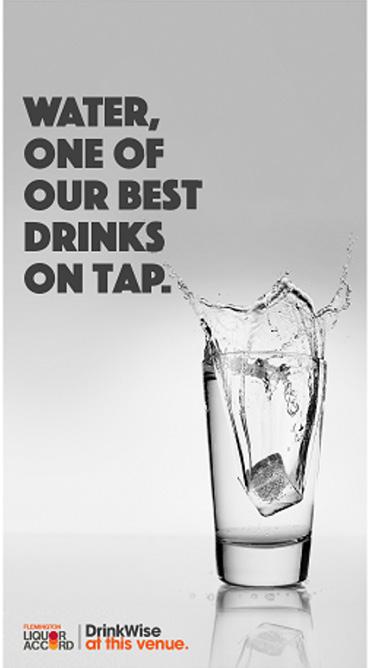

According to the latest findings from the National Drug Strategy Household Survey (NDSHS), conducted by the Australian Institute of Health and Welfare (AIHW), a significant and positive shift has been observed in norms around parental non-supply of alcohol.
The survey data shows that an overwhelming 89 per cent of parents are refraining from supplying alcohol to their underage teenagers, up from 87 per cent in 2019. This positive shift reverses a trend observed in the previous survey, which showed parental supply of alcohol (as the usual source) to underage teens had increased. This reflects the importance of educational efforts, such as the 2022-launched DrinkWise ‘It’s okay to say nay’ campaign, which is still airing today.
Creating awareness among parents about the risks associated with early alcohol consumption is critical, with research highlighting that both serves and sips for those who are underage can be detrimental to both teenage development and alcohol-related harm in their future years.
Despite the encouraging statistics that show more parents set strong boundaries in the home and do not supply alcohol to their underage teens, the survey also shows some very concerning misconceptions around underage drinking are persisting in the community. Shockingly, almost one-in-three respondents (32 per cent) believe that occasional consumption of one or two standard drinks by 16- or 17-year-olds poses no significant health risk and around one-in-four (24 per cent) think it is beneficial to provide 16- to 17-year-
olds with a little bit of alcohol to prepare them for drinking in adulthood.
We’ve seen a significant increase in underage teenagers abstaining from alcohol over the past 20 years. We need to recognise that the overwhelming majority of underage teens do not consume alcohol and continue efforts to ensure that such choices are encouraged.
We do know that for some parents talking to their teenagers about alcohol can be daunting, so we’ve worked with renowned adolescent psychologist Dr Michael Carr-Gregg and medical health expert Dr Andrew Rochford to develop tips for talking to your teenager about alcohol to help make these important conversations a little easier. Parents can find these tips on the DrinkWise website.
Ongoing education is crucial to discouraging underage drinking and helping parents understand their capacity to set boundaries and be positive role models, as this is pivotal to generational change when it comes to alcohol.
In an effort to ensure patrons can enjoy socialising at venues in a safe and responsible manner, DrinkWise is continuing to work with Liquor Accords across the country. We recently commenced a partnership with Northern Beaches Liquor Accord in Sydney and will work together to reinforce expectations around acceptable behaviour in licensed venues and retailers, as well as individual responsibility when entering any of the 300 Northern Beaches Liquor Accord venues. ■


“Ongoing education is crucial to discouraging underage drinking and helping parents understand their capacity to set boundaries and be positive role models.”Simon Strahan, CEO, DrinkWise, highlights a positive shift in the norms around parental non-supply of alcohol. Simon Strahan CEO DrinkWise
Catherine Wansink, Market Consultant
Australia for New Zealand Winegrowers, demonstrates Australia’s positive category sentiment for New Zealand wine.

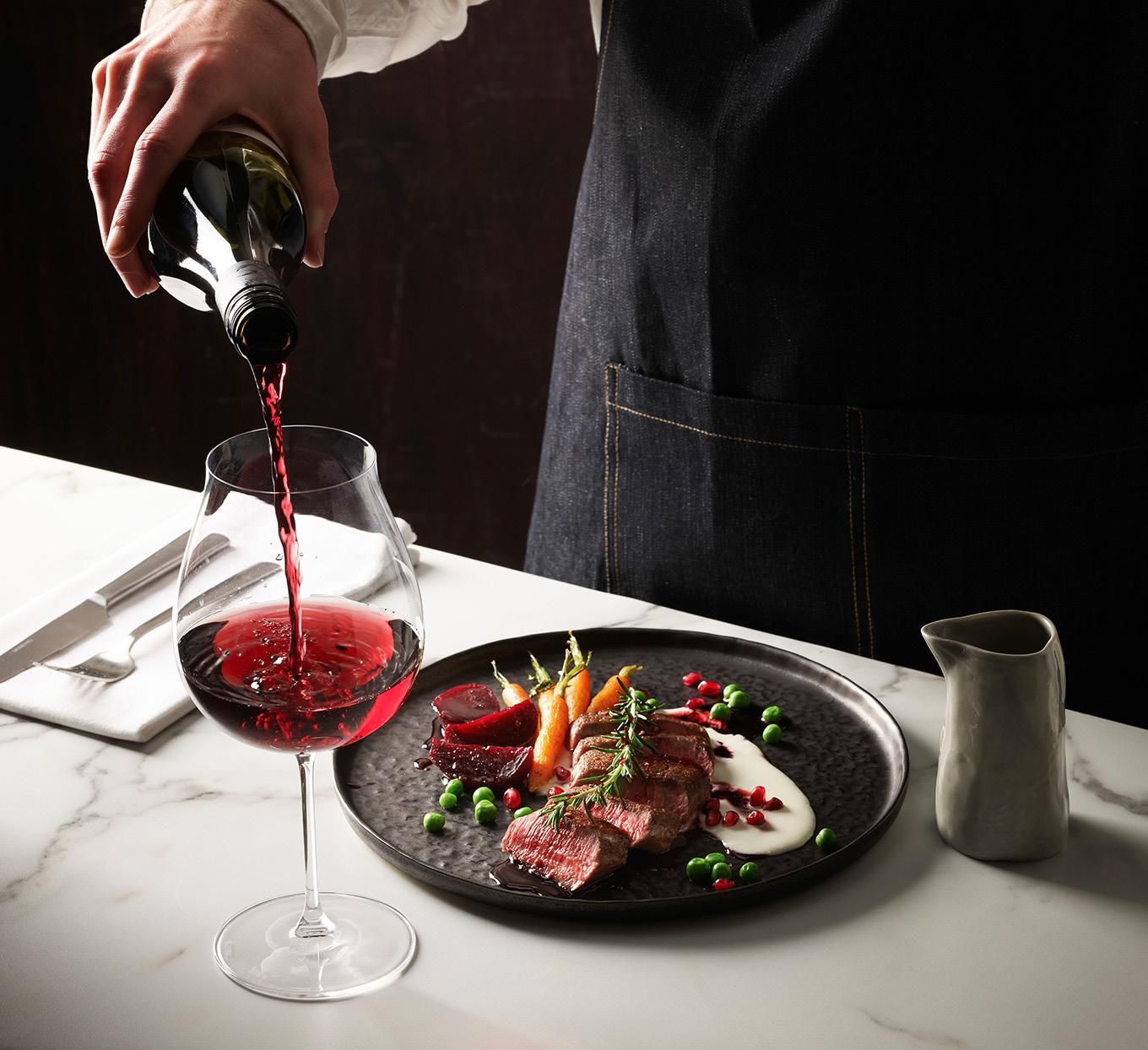
New Zealand Winegrowers recently presented the 2023 IWSR Consumer Perceptions of New Zealand Wine report. This was the second wave of research commissioned, with the 2022 findings establishing a benchmark. The research was conducted in-field during late 2023 across New Zealand’s pivotal wine markets: USA, UK, Australia, and New Zealand.
The research demonstrates that New Zealand wine drinkers in Australia are significantly more likely to be either Engaged Explorers (28 per cent New Zealand wine drinkers vs 16 per cent of regular wine drinkers [RWD]) or Contented Treaters (30 per cent New Zealand wine drinkers vs 19 per cent RWD). The first cohort is highly engaged in the category, wine is important to their lifestyle, and they always try to look for the best quality wine for their budget. They have a broad alcohol repertoire including Champagne, sparkling wine, spirits and RTDs and consume a wide range of varieties. The second group values wine for its extrinsic properties, such as the ability to create a warm or friendly atmosphere and to celebrate special occasions. They have less frequent consumption but have the second highest average spend in both the on- and off-premise.
New Zealand wine consumers in Australia are also significantly more likely to drink:
• 57 per cent drink Sauvignon Blanc, compared to 49 per cent of RWD
• 48 per cent drink Pinot Noir compared to 35 per cent of RWD
• 46 per cent drink Pinot Grigio compared to 35 per cent of RWD
• 41 per cent drink Champagne compared to 29 per cent RWD
• 41 per cent drink Craft Beer compared to 31 per cent RWD
• 36 per cent drink Prosecco compared to 30 per cent of RWD
They are significantly more likely to drink two to five times per
week (44 per cent vs 37 per cent RWD) and significantly more likely to be Highly Involved in the wine category (46 per cent vs 33 per cent RWD).
In terms of the power index for country-of-origin wines (combined awareness and consumption indices), New Zealand continues to rank second, with Australian wine in the lead.
It is interesting to note that while other countries of origin have remained stable, increases in awareness of New Zealand wine is translating into increases in purchase amongst premium wine drinkers ($15+), suggesting that increased exposure has positively influenced consumer buying habits.
The strongest brand image associations for New Zealand wine are taste, trust and quality, which are all key drivers of purchase. While the top associations for New Zealand wine have remained the same since the 2022 wave, an increasing proportion of Australian premium wine drinkers associate it with being modern and producing grape varieties they like.
New Zealand Trade and Enterprise commissioned research into the brand health of New Zealand Food and Beverage in key export markets revealed that wine is the most widely recognised New Zealand food and beverage import to Australia.
The research found that New Zealand’s Brand Health conversion remains strong and stable compared to other country of origin wines. New Zealand stands out from competitors for its environmental credentials, which contribute to perceptions of wine from a trusted place and is made with care.
Overall, category sentiment for New Zealand wine in the next 12 months is positive. The ‘New Zealandness’ of any export proposition will have a strong impact in the Australian market. ■
Sources:
New Zealand Wine Brand Tracker, IWSR Vinitrac, 2023
New Zealand Trade & Enterprise, Kantar, Made with Care, Wave 5 February 2024

Australia’s wine industry was hit hard by the imposition of tariffs by the Chinese government in 2020-21 and with signs pointing towards those tariffs finally being lifted, leading industry analysts IWSR have examined how the Chinese wine landscape has changed and what this will mean for Australian wine.
Hopes that the tariffs will be lifted increased last month with the interim recommendation from the Chinese government saying that the duties on Australian wine were no longer necessary.
China is currently reviewing its tariffs policy as part of an agreement that saw Australia suspend its dispute with the World Trade Organisation. That agreement was in place until 31 March, so the hope is that China’s announcement will come soon, and that the interim recommendation will see the tariffs on Australian wine removed.
However, this does not mean that Australian wine will immediately return to the $1.2bn worth of sales in China, particularly as Australia’s absence over the last three years has seen the likes of Chile and South Africa fill the void. In addition, IWSR highlights that the wine market
landscape in China has also evolved over the past few years, with overall volumes contracting.
“2022 was one of the most challenging years for China’s alcohol industry,” said Shirley Zhu, IWSR’s Research Director for Greater China.
“Rolling lockdowns and social restrictions limited consumption, and consumer spending waned. There will also be challenges with overstocks, as the Chinese market has rebounded slower than expected post-Covid.”
IWSR data shows a -26 per cent volume decline in total wine sales in China, 20212022, capping a 2018-22 CAGR of -16 per cent. 2024 will likely continue to be challenging for wine, but if the economic situation improves as expected, less pronounced declines (circa minus-two per cent volume CAGR) are forecast out to 2027.
For now, IWSR’s consumer recalled data shows that while wine originating from Australia has a significantly lower purchase incidence compared to 2019, it remains in the top three recalled purchased countries of origin. This underscores that Chinese sentiment about Australian wine remains positive and may foster a quick rebound in
sales once the supply chain has recovered.
Another change in China’s wine landscape is the growing awareness of locally produced wine, with increasing recognition of regions including Ningxia, Shandong, and Shanxi and Xinjiang.
IWSR said: “Many industry stakeholders, however, believe the rebound for Australian wine will require a structural overhaul of the Australian wine industry. The oversupply issue is viewed by some to reach as far back as 2017 when Chinese wine consumption began declining significantly, but production of cheaper wine continued unabated. The addition of large harvests in 2020 and 2021 added to inventory levels.
“With Australian wine stocks currently at an all-time high, many wineries are struggling with oversupply, which will become even more pronounced with the upcoming vintage. France’s recent response to overcoming the wine surplus in Bordeaux has been a package including the up-rooting of vines, compensation for growers and a distillation campaign to lessen overstocks.
“While re-entering China will not be a silver bullet for Australian wine, producers are hopeful that it will help boost the industry’s outlook.”■


“Tenants
must vigilantly monitor neighbouring businesses and promptly address any breaches or infringements of their exclusive rights.”
Marianna Idas Principal eLease LawyersCommercial leases outline the terms of occupancy between landlords and tenants. Among the many clauses and provisions, exclusivity is a crucial element, offering tenants protection and competitive advantage within their chosen niche. From the tenant’s perspective, exclusivity clauses can be a double-edged sword, offering both opportunities and challenges.
Exclusivity clauses grant tenants the exclusive right to conduct certain types of business within the leased premises, prohibiting landlords from leasing adjacent spaces to competitors. For tenants, this provision holds significant value, safeguarding their market share and ensuring they operate in an environment conducive to success to reduce competition on the land. By securing exclusive rights to their particular trade or service, tenants can foster customer loyalty and capitalise on a captive market. For instance, a specialty coffee shop nestled within a commercial complex can thrive knowing that no other coffee vendor will set up shop nearby, bolstering its chances of becoming the go-to destination for caffeine enthusiasts in the area.
Securing exclusivity is particularly advantageous for business owners intending to sell their enterprise as it enhances its marketability and perceived value to potential buyers. Prospective investors or buyers are more inclined to invest in businesses operating within a protected market space, as exclusivity guarantees a certain level of insulation from immediate competition, thereby ensuring a stable revenue stream and customer base. This assurance can significantly bolster the attractiveness of the business and increase its salability, ultimately facilitating a smoother transition for both the seller and the buyer while safeguarding the business’ profitability and long-term sustainability.
However, the pursuit of exclusivity comes with challenges and considerations for tenants.
Marianna Idas, Principal, eLease Lawyers, discusses the significant value of exclusivity clauses in commercial leases.
Negotiating exclusivity clauses should be done with the assistance of a legal advisor that specialises in leases. The exclusivity clause must meticulously define the scope of exclusivity, specifying the types of businesses or services covered under the agreement to prevent ambiguity and loopholes. Caution should be exercised to ensure the tenant’s use is still able to be wide enough to adapt to evolving market trends or diversify their business offerings. Striking a balance between exclusivity and adaptability is essential.
A lawyer can help with the wording to protect the tenant’s rights. In a case involving a fruit and vegetable store in a shopping centre, the lease contained an exclusivity clause that stated that they would be “the sole independent fresh fruit and vegetable operator”. The wording here unfortunately did not stop a major supermarket selling fruit and vegetables as the court held that they were not independent and therefore not covered by the exclusivity clause. The tenant, in this case, lost hundreds of thousands of dollars due to the clause not being drafted correctly.
Another consideration for tenants is the enforcement and compliance of exclusivity clauses throughout the lease term. Tenants must vigilantly monitor neighbouring businesses and promptly address any breaches or infringements of their exclusive rights. Establishing clear protocols for dispute resolution and recourse mechanisms can mitigate potential conflicts and uphold the integrity of the exclusivity agreement.
Tenants should obtain legal advice from a lawyer who specialises in leases at the start of negotiations to get the best possible deal and ensure their interests are safeguarded. This can include a well drafted exclusivity clause that protects the tenant and gives them flexibility to grow their business. ■

In every business where there are more than three or four people working, it is possible to define whether there is a ‘pulling up’ mentality or a ‘dragging down’ mentality occurring. And despite staff training, the establishment of rules and procedures and the presence of a hardworking manager, these two factors (and of course, shades in between) can make or break a business.
Let’s go back one step and analyse the team dynamics at play here. If you have a staff member who doesn’t feel like they’re a stakeholder in the business, they’re most likely to play the ‘lowest common denominator’ game i.e. Who’s looking? What can I get away with? Or he/she gets away with it so I can as well.
Now, I don’t mean financial stakeholders here of course. The challenge for every business owner/ manager is to ensure staff members are involved, utilised and made to feel part of the team. The surest way to secure a ‘dragging down’ mentality is to have uninvolved, under-utilised or unappreciated staff and, of course, a manager playing favourites.
Let’s be fair here (and a little realistic), how can we ensure a two-shift-a-week casual gets involved in the business and becomes a stakeholder? They’re not even thinking about the place on the five days they’re not there and, in reality are only there for the pay packet. Well, these are the cards that have been dealt to us as managers in a retail liquor business. We hire on a casual basis because it suits our business model and cost structure. We have to work around these difficulties or the ‘pulling up’ mentality is a glorious but unattainable vision.
In my October 2023 article, I mentioned setting a staff

“A ‘pulling up’ mentality comes from staff who want to be there, feel involved just a little, feel that their work may lead somewhere or at least give them skills for a later role and, most importantly, to work around likeminded people.”
Peter Hall Industry Consultantquestionnaire every month, in part testing and in part setting the expected standard. Ten questions on product, price, food/drink matching, RSA… you get the idea. This is a great way to involve staff and you’ll very quickly find out who’s keen to learn more (pulling up) and who doesn’t see it as part of their job (dragging down).
What is your opportunity in making each staff member a ‘Champion’ in one particular stock category? They could get more involved in displays of their category, get more in-depth in product knowledge and could assist with sharing that knowledge around the team.
How do you communicate with staff when they’re not at work regarding rosters, upcoming promotions, new stock arriving, display changes etc? Well, apart from rosters we usually wait until they’ve come to work and then we’re playing catchup. I have also previously mentioned staff who put up barriers to being trained and will often ‘white-ant’ your efforts. My question is, can you afford to have that person working for you? During Covid times, it was tricky getting (good) staff however there’s less excuse now.
A ‘pulling up’ mentality comes from staff who want to be there, feel involved just a little, feel that their work may lead somewhere or at least give them skills for a later role and, most importantly, to work around like-minded people. So, what skills does a manager need to pull all this together? He/she must be able to set minimum standards and get people to work on time but also ignite a passion for the industry and for their business. And these skills must be in evidence each and every day.
Food for thought. ■

Planograms are a powerful tool for retailers, particularly in the world of fast-moving consumer goods, including off-premise liquor, where shoppers are faced with a multitude of choice and often a wall of noise and confusion.

“By working together, suppliers can help stores optimise their product offerings and shelf layouts, leading to increased sales and customer satisfaction for all parties involved.”Stephen Wilson Category & Insights Manager Strikeforce
Data-led, data-driven planograms optimise sales based on historical performance, built from the most granular level to deliver a category offering that maximises valuable retail space and return on investment for retailers.
The quest for perfect in-store product placement seems like a straightforward goal; ensure stores carry the right product mix and present them effectively (planograms, or POGs). Yet, the reality paints a different picture.
Planograms are meticulously crafted, outlining the ideal product assortment for a store based on factors like customer demographics and sales history. Stores that abide by these guidelines benefit from a curated range that caters to their specific shoppers and maximise sales potential. While stores often follow ranging guidelines, layout consistently and adhering to both ranging and POG recommendations can be patchy.
There are reasons why stores only partially embrace POGs and here are a few examples:
Stores often negotiate preferential shelf space with smaller, local suppliers who may offer better margins or promotional benefits. These deals can disrupt a meticulously planned POG, forcing substitutions and this can dilute the power of collective negotiation made by banner groups on behalf of member stores.
Many stores, especially larger chains, have
established category management teams responsible for product ranging and organisation. These teams may prefer their own categorisation methods over supplier suggestions, potentially leading to deviations from the POG.
Not all stores have identical layouts or equipment. Fridge dimensions, for instance, might not perfectly accommodate a supplier’s POG, necessitating adjustments for optimal product storage.
To overcome the ranging and POG compliance gaps, collaboration is key. There are strategies that stores can apply to reach a happy medium.
Flexibility in POG design, where more adaptable POGs or store specific layouts using core range as the base, offer a solution that caters to different store configurations.
Centralising sales and market data as the bedrock of ranging decisions to demonstrate the effectiveness of POG recommendations, driving home the benefit of store compliance in return for demonstrated sales uplift.
Creating a joint category management plan where suppliers and stores can collaborate on category management, creating joint plans that leverage the supplier’s expertise while respecting the store’s existing structure.
Achieving high compliance with both ranging and POGs requires a shift in perspective. It’s not about control, it’s about mutual benefit. By working together, suppliers can help stores optimise their product offerings and shelf layouts, leading to increased sales and customer satisfaction for all parties involved. ■


For the latest liquor retail news, subscribe to the National Liquor News e-newsletter

RTDs represent an incredibly popular drinks segment, with many brands and new products entering the space. Caoimhe Hanrahan-Lawrence explores this vibrant category.
The diverse and growing RTD category is expected to hit US$40b globally by 2027, according to the IWSR. While the rate of growth has slowed in recent years as the category consolidates, consumers are still being drawn to the category due to its broad appeal for the modern consumer. RTDs offer convenience, innovative flavours, and appeal to current drinks trends, such as the better-foryou movement, flavour nostalgia, and the desire to buy local.
RTDs are particularly popular among legal drinking age (LDA) Gen Z and millennial consumers, according to Belinda Sieben, Communications Manager, Australian Vintage Limited (AVL).
“RTDs fit with younger consumers’ lifestyles, are easy to consume, easy to moderate, and easy to share. It’s the perfect match. RTDs are bought based on occasion, promising the perfect drink for the Australian lifestyle, whether that be outdoors, at a music festival or just catching up with friends,” she said.
Among these younger adult consumers, RTDs are frequently consumed in social settings. As such, festivals are key exposure events, and brands such as Archie Rose and AVL are joining as drinks partners with entertainment companies, exposing more consumers to their products.
Despite the focus on LDA Gen Z and millennial drinkers, the interest in RTDs is evident across multiple age groups. There is, however, a generational difference as to where new RTD drinkers are coming from, as Susie Goldspink, Head of RTD Insights, IWSR, explained.
“IWSR consumer data suggests RTDs are primarily stealing share from beer, but there are interesting differences in age groups, with the LDA Gen Z cohort most likely to replace spirits with RTDs, and boomers most likely to replace wine,” she said.
As the name suggests, ready-to-drink products offer convenience, which is particularly appealing for consumers looking to purchase for social gatherings.
According to Alex Bottomley, co-Founder and Director, Ampersand Projects, this is particularly true for canned long drink style RTDs.
“Products are generally purchased to be consumed on a single and immediate occasion,” he said.
However, convenience means different things for different styles of RTDs, such as bottled cocktails, as Trevor Hannam, Head of Sales, Archie Rose told National Liquor News
“While both our ranges can be enjoyed for any occasion, the cans are perfect for parties, picnics and festivals, while bottled cocktails are perfect to drink in the comfort of your own home, or to take to a dinner party or house party, taking the pressure off mixing your own cocktails,” he said.
Gemma El Kazzi, co-Founder of bottled cocktail business The Skandi Selection, expressed a similar view.
“People reach for a canned RTD for a quick and easy drink, whereas bottled cocktails like ours are somewhere in the middle. It’s still quick and easy, but you need to pour it in a glass, and you need to dress it to have that cocktail feel about it,” she said.
Additionally, RTD consumers seek out new and
engaging options, with the IWSR reporting taste innovation as the main reason for drinkers switching to RTD from other categories. According to Zoe Wendland, Marketing Director, Fellr, this has been supported by new product development in the category.
“There’s a growing preference for premium and innovative RTDs, driven by consumers’ desire for what’s hot, and quality and unique flavour experiences,” she said.
Interestingly, one area of flavour innovation has been in nostalgic flavours, with many RTD releases reflecting flavours from the childhood of LDA Gen Z and millennial consumers.
Refreshment is particularly important for RTD consumers, which has led to growth in lemon flavoured RTDs, as Jorge Rosas, Category Manager RTD, Beam Suntory, remarked.
“The citrus segment is rapidly expanding in Australia’s RTD category, with consumers associating citrus flavours with refreshing drinking experiences. Citrus flavours have rapidly increased in popularity as they are often paired with refreshing spirit bases such as vodka, gin and seltzer,” he said.
Many drinks categories have been affected by the betterfor-you trend, but it is particularly evident in RTDs.
“Better-for-you, low calorie drinks continue to lead the way as drinkers seek options that are either no or low sugar, and lower in calories compared to other categories such as beer and wine,” Bottomley said.
Many brands, such as Archie Rose, choose to prominently display their product’s sugar or calorie count on the packaging.
“By offering this transparency on the cans, we’re simply making it easy for consumers to see the choices available in this category and hopefully introducing Archie Rose to a new audience,” Hannam said.
“Australian drinkers have always had a preference for vodka RTDs and as the RTD category continues to outperform other categories, it’s the vodka-based products that are leading the way. The neutral nature of the spirit leads to greater refreshment and less harsh drinks which appeals to the RTD drinker’s palate.”
Alex Bottomley, co-Founder and Director, Ampersand Projects

1. Stock for a diverse range of consumers
“Ensure that different strengths of products are positioned and merchandised together.
“Allocating adequate space in-store for both market-leading products are new innovative products to ensure consumers have a selection to remain engaged in the category,” Bottomley said.
2. Highlight new products
“While RTD drinkers, like all drinkers, have their preferred brands, loyalty isn’t the ultimate deciding factor at the point of purchase. If customers see something new on the shelves that’s in their wheelhouse, their curiosity will usually see them reach for it,” Hannam said.
3. Consider cross-merchandising
“We also know that the consumer isn’t necessarily shopping by category but more by occasion or need, and see many retailers exploring crossmerchandising opportunities, such as placing complementary products together,” Wendland said.

Despite the popularity of better-for-you products, there is also a growing demand for high ABV products.
“Consumers are increasingly looking for value for money, which has continued to drive demand for High ABV RTDs in Australia. Products with an ABV of six per cent or higher have performed strongly over the past few years as it offers good value for money for many shoppers, seeing rapid share gains of brands such as -196 and other brands on the market,” Rosas said.
The RTD category is diverse, but spirits-based RTDs undoubtedly dominate, with the IWSR reporting that cocktails and long drinks make up 70 per cent of all RTD products.
White spirits have been popular due to their approachable taste, allowing for greater flavour innovation.
“Australian drinkers have always had a preference for vodka RTDs and as the RTD category continues to outperform other categories, it’s the vodka-based products that are leading the way. The neutral nature of the spirit leads to greater refreshment
and less harsh drinks which appeals to the RTD drinker’s palate,” Bottomley said.
While white spirit consumption has been primarily seasonal in the past, this is changing as more consumers enter the category.
“Traditionally, white spirit premixes were mostly consumed in summer and dark spirit premixes in winter, although dark spirit drinkers have always been more inclined to drink it all year round. We’re now noticing white spirit premix drinkers follow suit, with consumers enjoying their drinks in the colder months so it’s not as hugely seasonal as it used to be,” Hannam said.
This said, there are still seasonal changes in RTD consumption. Flavours such as citrus and watermelon dominate sales in summer, as consumers look for refreshing options for outdoor drinking occasions. In addition, larger pack sizes to 10 or 24 cans see strong sales during holiday periods and sporting finals.
In the future, Sarah Camerlengo, Brand Manager, Vok Beverages, expects to see more interest in dark spirits as these products modernise.
“As the category continues to evolve, I
believe we will start to see the dark spirit RTD space expand and grow as the white spirit RTD space continues to become more and more crowded. It is a growth opportunity and a way to recruit new consumers into the RTD category especially for consumers wanting to seek something a little bit different,” she said.
Other spirts may also take hold in the future, according to Michael Newbold, Senior Brand Manager, Vok Beverages.
“If you look at what we’ve seen in markets like the US, I think there are a number of spirit categories primed for domestic expansion in the coming years. Australian Rum and Whisky RTDs are under-developed given the number of established distilleries. Tequila in another massive opportunity for retailers; simple canned options for drinks like Ranch Water and Palomas are a great way to recruit people into the Tequila category,” he said.
One of the hottest RTD segments is the seltzer category, which has seen a massive increase in popularity and consumption in recent years. These beverages are refreshing, and generally tap into the demand for better-for-you products.
As part of the broader spirits based RTD subcategory, there can be some blurring between seltzers and other light spirit RTDs, particularly those made with soda. Flavour innovation is also becoming increasingly important in the seltzer category, just as in other RTD segments.
“We believe success lies in embracing the product’s unique selling point and leveraging the blurring of lines with light premix drinks to attract a broader audience of health-conscious consumers looking for refreshing, lower-calorie options without compromising on taste and quality,” Wendland said.
An emerging sector of the RTD category is wine-based RTDs, or spritzers. These products straddle the divide between RTDs and wine, providing convenience and flavour with a wine base, rather than spirits. This is becoming an area of interest of wineries seeking different avenues to appeal to LDA Gen Z and millennial drinkers. Spritzers also appeals to older generations switching wine for RTDs.
“A global trend is ‘what was old is new again’ and we saw there was a job to be done to bring younger LDA consumers into wine and drive more relevance in this category,” Siebsen said.
In such a crowded market, Australian RTD producers are performing remarkably well, and offer significant benefits to Aussie consumers.
“The role Aussie RTD producers play in the market is similar to the role Aussie spirit makers play, and that’s to provide consumers with options that carry all the benefits of spirits that are locally produced, containing natural, Australian local ingredients, and

“While both our ranges can be enjoyed for any occasion, the cans are perfect for parties, picnics and festivals, while bottled cocktails are perfect to drink in the comfort of your own home, or to take to a dinner party or house party, taking the pressure off mixing your own cocktails.”
Trevor Hannam, Head of Sales, Archie Rose


other sustainability factors such as reduced air miles and freight costs,” Hannam said.
In addition, Australian producers have a better understanding of what Australian consumers like, how they drink, and what they care about.
“As an Australian brand, we take pride in developing drinks that cater to the needs, values, and culture of today’s generation of Aussies. We recognise the shift towards refreshing and lighter options in the alcoholic beverage landscape, and we’ve tailored our offerings to meet those preferences,” Wendland said.
For many Australian brands, supporting the local community is an important part of their business values, which can increase consumer identification with the brand.
“Championing culture and community is at the heart of our marketing ethos. Our commitment to supporting creative communities has resonated with consumers and will continue to be a part of how we show up in their world,” Wendland added.
Of course, Australian consumers are still influenced by international trends, as we have seen with the rising popularity of seltzer following US trends, and the introduction of Japanese brands to the Australian market.
The Australian appetite for RTDs is evident, and there are many different reasons for consumers to engage with the category. By understanding the trends influencing RTD consumption and staying on top of the diverse styles, retailers can make the most of this growing market. ■

“The citrus segment is rapidly expanding in Australia’s RTD category, with consumers associating citrus flavours with refreshing drinking experiences.”
Jorge Rosas, Category Manager RTD, Beam Suntory
According to the IWSR, more than half of consumers are influenced to purchase an RTD if it is made by a well-known spirits, beer, or soft drink brand. This effect has certainly been noticeable by Archie Rose.
“When it comes to our RTDs, the goal was really to ensure our awardwinning spirits could deliver a much higher quality canned drink to more Australians, which helps the consumer to expect more from an RTD which are typically high in sugar and artificial ingredients. Diversifying in this way allows us to reach a new audience through the accessibility of this range,” Hannam said.
However, Newbold thinks that this trend is less pronounced among dedicated RTD consumers.
“Brands with established credentials in spirits will always have a level of advantage stepping into the RTD space but I think what we’re seeing from consumers is a real intent to explore the category and actively seek out something new,” he said.
There are also RTD brands bucking the trend and releasing spirits, such as Ampersand Projects Vodka & 500mL, a classic vodka that takes its cue from the convenience of RTDs with a smaller bottle size.










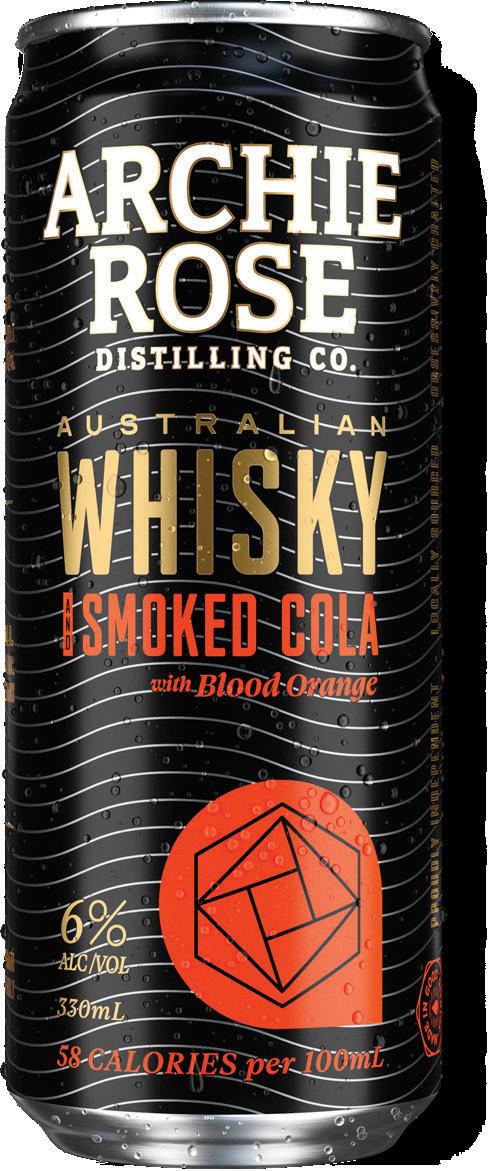
As tradition and innovation intertwine, Molly Nicholas discovers how family wineries are finding the balance between preserving heritage and embracing contemporary techniques.

In the realm of liquor retail, where tastes and trends change rapidly, the history and longstanding tradition of family-owned wineries offers an enriching experience for wine lovers, drawing on invaluable winemaking knowledge, which has shaped the industry that exists today.
Rooted in generations of viticultural expertise and a unique connection to the land, family-owned wineries tell a story of authenticity that resonates with consumers. But how, as consumer palates evolve and winemaking practices advance, are they competing with emerging brands?
Elizabeth Calabria-Staltare, third-generation family member and Head of Marketing at Calabria Family Wine Group, grew up around the winery with fond memories of vintage season, and seeing firsthand the sacrifices her parents made to survive in the

family business ignited her desire to carry on the family legacy.
“It was not an easy journey for our grandparents and parents who struggled financially for many years. We grew up watching my dad pivot the business in 1989 to wash bottles for other well-established wineries, just to give the winery some cash flow. Not romantic, but that hard work is what we remember,” she says.
“Dad has been an incredible source of stability, always sharing valuable advice about the industry’s ups and downs, which taught us to build resilience. It has always been important to bridge traditions and innovation, and remain committed to the family values, but also branch out.”
Fourth-generation family member and Head of Innovation for Brown Family Wine Group, Emma Brown agrees that family legacies are invaluable to winemaking.
“When you lose people, you often lose
intel, but we have family who have been here since day dot, who can say, ‘yeah, we tried this style 40 years ago and here’s why it didn’t work’. It’s amazing how much we have used the information from our history and legacy to inform our innovation today.”
Along with their generational passion for winemaking, family wineries are often perceived as having a stronger connection to the land, usually rooted in the local culture and terroir and honouring traditional winemaking practices.
The future and sustainability of winemaking are important considerations for any winery, but with such a long-lasting history, environmental consciousness and sustainable agriculture is a top priority for Angove Family Winemakers.
Matt Redin, Marketing Manager at Angove Family Winemakers, says: “Embracing sustainability ensures that the business remains relevant and responsible in
the face of changing consumer preferences and global challenges related to climate change and environmental degradation.
“Balancing the preservation of tradition with a forward-looking approach to sustainability contributes to the continued success and resilience of the winery in the years to come.”
For Morris of Rutherglen, which is owned by Casella Family Brands, the history of the winery spans 160 years, making long-term sustainability of the land essential. Madden Morris, Chief Winemaker and sixth-generation Morris, says that as a generational winery, Morris strives to leave any vineyard or land that it works on in its best condition for the generations to come.
“At Morris, we see ourselves as stewards of the land and are entrusted to take the best possible care of our vineyard, winemaking and wine stock for future generations. Our industry depends so much on the land, and we need to show it the respect it deserves.”
With tradition comes expectation, and it’s this element of family legacy that often challenges later generations. At Dal Zotto, Co-Owner Christian Dal Zotto says that he and his brother, Michael Dal Zotto, Chief Winemaker, honour

tradition as much as they possibly can without letting it stifle innovation.
“In our family business, we try to upkeep and respect what it is that we have been brought into, while trying to keep up with an ever-changing market so that we can stay ahead of the game, it’s a balancing act.
“As a tiny player in the world of wine giants, we can be quite dynamic. For us, embracing innovation means that we still have a connection to who we are and what our brand is. It’s got to show off our unique story, and the personal touch that we can give as a small family winery.”
Brown believes that generational knowledge helps Brown Family Wine Group stay true to its course and avoid knee-jerk reactions to market conditions, but it hasn’t prevented the winery from building a legacy steeped in innovation.
“Innovation is something that has driven our journey for the last 135 years,” she says. “That has meant that we’ve had to really hone in and become consumer obsessed. It’s about being consumer obsessed rather than winemaking obsessed, and having the consumer at the heart of everything we do.”
With not only wine, but the broader alcoholic beverage industry continually evolving, and consumer palates changing over time, staying ahead of such changes is crucial
Post-pandemic we have seen a drive from consumers to support Australian producers in all industries, and while Dal Zotto says that this shift has not gone unnoticed in winemaking, he believes local producers have also started to pay more attention to retailers.
“During Covid, we were all put on the spot and the thing that helped us survive was retail, which was challenging because a lot of our on-premise customers went through hard times, but we found an amazing position with our retail customers and formed great relationships.
“Overall, we found that we gained support in the marketplace, not just Dal Zotto, but winemakers as a collective. Retailers really stood behind what was local first, and they’re still doing it. Those that aren’t are finding out pretty quickly that consumers want to know their local wineries are being supported.”
“If you ever stop learning or trying new things in any industry your competitors will pass you by.”
Madden Morris, Chief Winemaker, Morris of Rutherglen


“It’s about being consumer-obsessed rather than winemaking-obsessed, and having the consumer at the heart of everything we do.”
Emma Brown, Head of Innovation, Brown Family Wine Group
for the wine industry given the length of planning cycles.
Although traditional winemaking practices form the foundation at Morris of Rutherglen, each new generation has brought its own ideas to the table and incorporated newer techniques.
“If you ever stop learning or trying new things in any industry your competitors will pass you by. There can be a lot of trial and error with contemporary techniques, so we will start with smaller batch trials, then if successful it might be incorporated into our normal practice,” Morris explains.
Hailing from Australia’s oldest commercial grape growing region, the Hunter Valley, Angus Vinden, second-generation winemaker and viticulturist at Vinden Wines, expresses the importance of understanding rules before trying to change them.
“Tradition is not stagnant, it should constantly be redefined as we learn from the previous generation. I believe it is my responsibility, just as O’Shea did up on the old hill, to continually redefine and reinvent the Hunter Valley.
“In a traditional region people hate change, but change is inevitable. I would rather be leading it through our regenerative farming and winemaking

philosophies than being out of touch. The Hunter has always been a progressive winemaking region and we are seeking to help redefine new regional styles, which are respectful to our vineyards.”
Sharing this sentiment, Leanne De Bortoli, third-generation family member and Manager at De Bortoli Wines, cherishes what has happened in the past while acknowledging that the fabric of the business was formed around instincts.
“We need to remind ourselves that [our founder] established a successful business based on what they saw as the community needs and interests at that time. There was a gap and they filled it.
“Fast forward a century and it is no different. We try to stay on top of the changing conditions whether it is climate change, differing preferences in style of wine or market conditions. We are trying to anticipate what and how wine consumers may drink in the future and respond to that need, and we are asking them to trust us.”
In an age where consumers are seeking authenticity, family-owned wineries are well positioned to tap into this demand.
Looking to the future, Brown sees strategic collaboration and partnerships between familyowned wineries and retailers as the key to maintaining long-term success.
“A lot of independent retailers are also familyowned, and if you’re looking for true category innovation and true category commitment, that’s where family businesses really come in spades.
“It’s important to consider how you partner with each other into the future, to make sure that we have a really sustainable category moving forward that excites people, is easy to shop, and delivers on the excitement that other alcoholic beverage categories are probably better known for.”


At Calabria Family Wines, Australian consumers have shown the family great appreciation of not only the wine, but the story behind the brand.
“Each bottle is marked with our family’s name and is a testament to our commitment, resonating with consumers who seek quality and authenticity,” says Calabria-Staltare.
“It is a heartfelt connection to generations past and future, it is a special touch to know that another family is sitting around the table enjoying a glass of wine that is crafted by our family.”
For family-owned businesses, building long-term relationships and consumer loyalty are essential to market endurance, and Dal Zotto says the real draw for consumers is knowing that there is a connection to something deeper than just a bottle of wine.
“The consumer loves the charm of knowing that their wine was crafted with care, and created by people who have their history entrenched in the soil of the vineyard. It’s the techniques and traditions passed down from generation to generation with pride and authenticity.”
Typically, we assume that older demographics may have a deeper connection to family winemakers, with a greater appreciation for tradition and storytelling.
Speaking about consumers aged 35 and above, Redin says: “They are typically consumers who are more passionate about wine and view it as more than just a beverage. This group often values the craftmanship, history and unique stories associated with each bottle.”
In saying this, he also believes that family wineries are well positioned to connect to younger demographics through digital platforms,
advising: “Younger consumers are generally not as knowledgeable about wine so try and speak in a voice and use language they understand – banging on about malolactic fermentation and different clones will lose them – talk more about what it gives the wine in terms of taste and appeal.”
In the retail environment, Warwick Brook, NSW State Manager for De Bortoli Wines, says the sense of trust and value associated with family-owned wineries, and loved by consumers, shouldn’t be forgotten.
“Place family brands in a prominent position within the store and let them shout from the shelves who they are and what they are,” he says. “Remember, always ask those companies to help with shouting, by merchandising and conducting consumer tastings where possible.” ■
“Balancing the preservation of tradition with a forward-looking approach to sustainability contributes to the continued success and resilience of the winery in the years to come.”
Matt Redin, Marketing Manager, Angove Family Winemakers

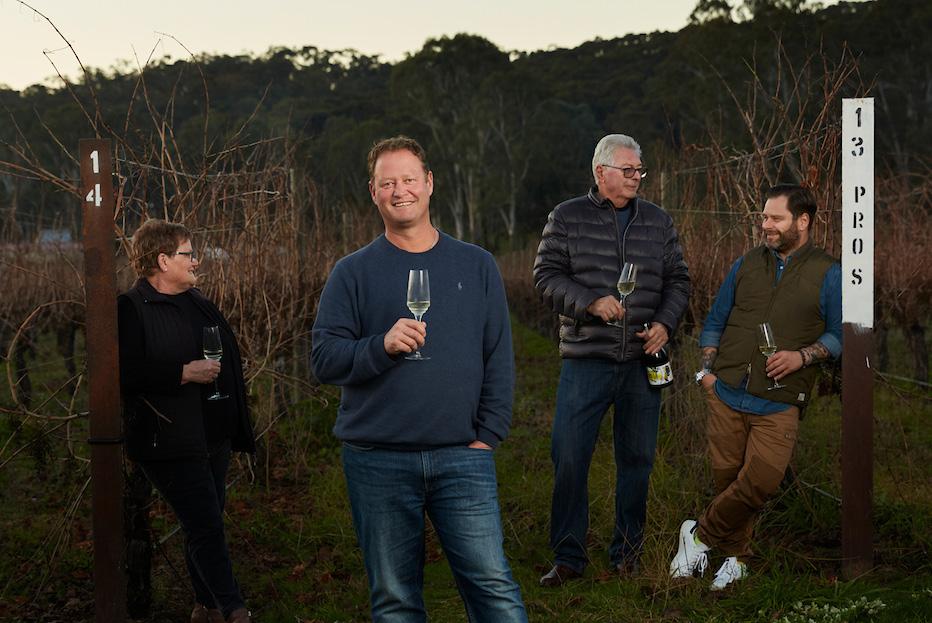
“The consumer loves the charm of knowing that their wine was crafted with care, and created by people who have their history entrenched in the soil of the vineyard.”
Christian Dal Zotto, Co-Owner, Dal Zotto Wines

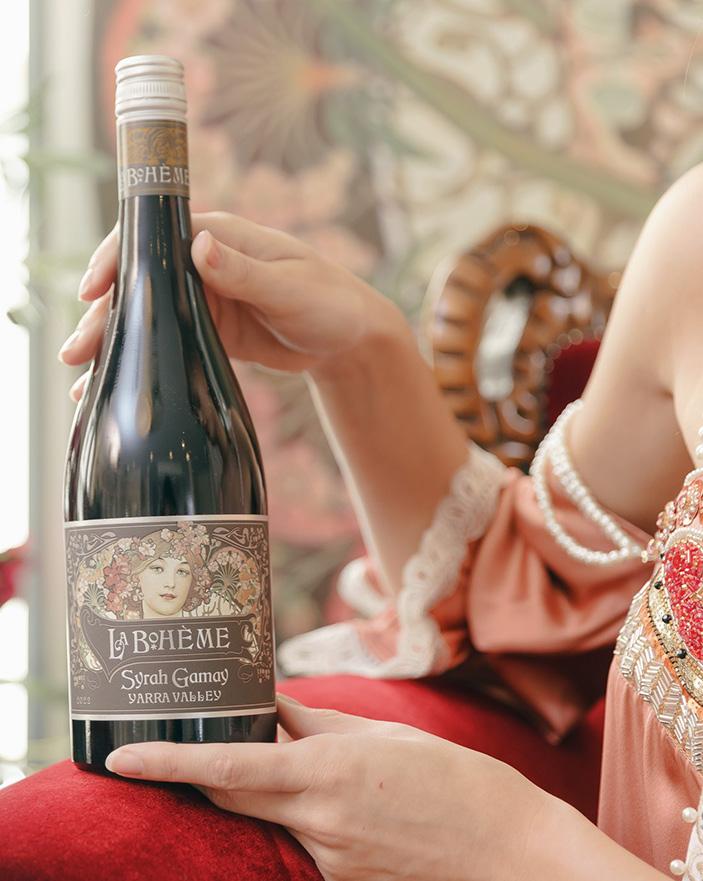

Last month De Bortoli Wines hosted a lavish celebration of art, fashion, and wine in collaboration with visionary designer Viceta Wang and the 2024 PayPal Melbourne Fashion Festival’s Independent Programme.
The day was filled with glamour, sophistication and sensory delights, transporting guests to the enchanting Art Nouveau era.
At the heart of the event was De Bortoli Wines’ iconic La Bohème wine range – a collection that embodies elegance, sophistication, Parisian charm and the beauty of the Australian landscape.
The La Bohème wines pay homage to the timeless artwork of visionaries from the Art Nouveau era. With labels adorned in intricate designs, each bottle is a work of art in itself.
At the event, guests had the opportunity to experience the convergence of art, fashion, and wine against a backdrop of Art Nouveau-inspired décor, Viceta Wang unveiled her Summer/Spring 2024 collection, inspired by De Bortoli’s La Bohème wine range.

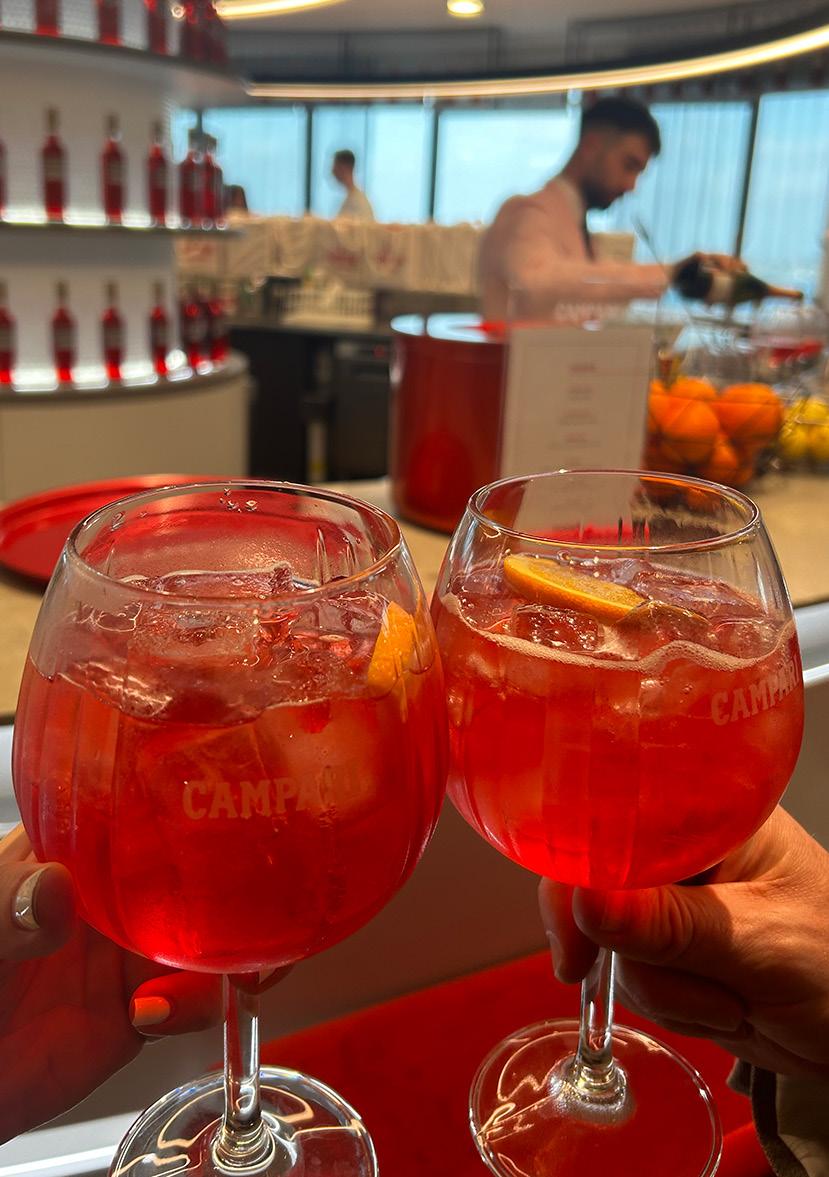
Campari welcomed members of the trade into their Sydney office for Aperitivo Hour to celebrate the launch of the new Campari bottle.
Krystal Hart, National Bartender Engagement and Trade Advocacy Manager at Campari Australia took attendees through the rich history of the brand and the evolution of an icon, while they enjoyed some classic Campari cocktails.
Campari has redesigned its bottle with an innovative and timeless design inspired by Milano, the birthplace of the Aperitivo ritual.
Campari is available at retailers including Dan Murphy’s, BWS, First Choice, Liquorland, Vintage Cellars and selected independent retailers for RRP $50.
 industry
industry

During his recent visit to Australia, Duncan Shoulder, Chief Winemaker at Giesen, hosted two trade tastings, highlighting the diverse varietals coming out of the Marlborough region.
The highlight of the tastings were the three wines from Giesen’s Clayvin range, comprising a Chardonnay, a Pinot Noir, and a Syrah. Located in the Southern Valleys, the Clayvin vineyard is predominantly clay soil, and lined with dense plantings of 30-year-old vines.
The Clayvin vineyard is also organically farmed, which Shoulder explained is important for the winery’s longevity.
“When you put a crop in the ground, you’re thinking about the next 30 to 40 years that it’s going to grow and develop. One of the best ways to do that is to look after the land on which it is planted.”
The Macallan held its first ever Australian pop-up from 7 to 10 March at Sydney’s Hickson Road Reserve in celebration of its partnership with Stella and Mary McCartney on the third edition of The Harmony Collection.
The immersive pop-up showcased the partnership behind the Macallan Harmony III, referencing natural motifs that evoked the Scottish heritage and connection of the collaboration. Unique photography by Mary McCartney was also displayed throughout the venue.
Guests were invited to taste and learn about the Harmony III limited release and add their own personal touches to cocktails by picking from the garnish garden. There was also a sensory virtual reality drinking experience, and the Macallan Harmony III Amber Meadow was available for purchase from the bar.

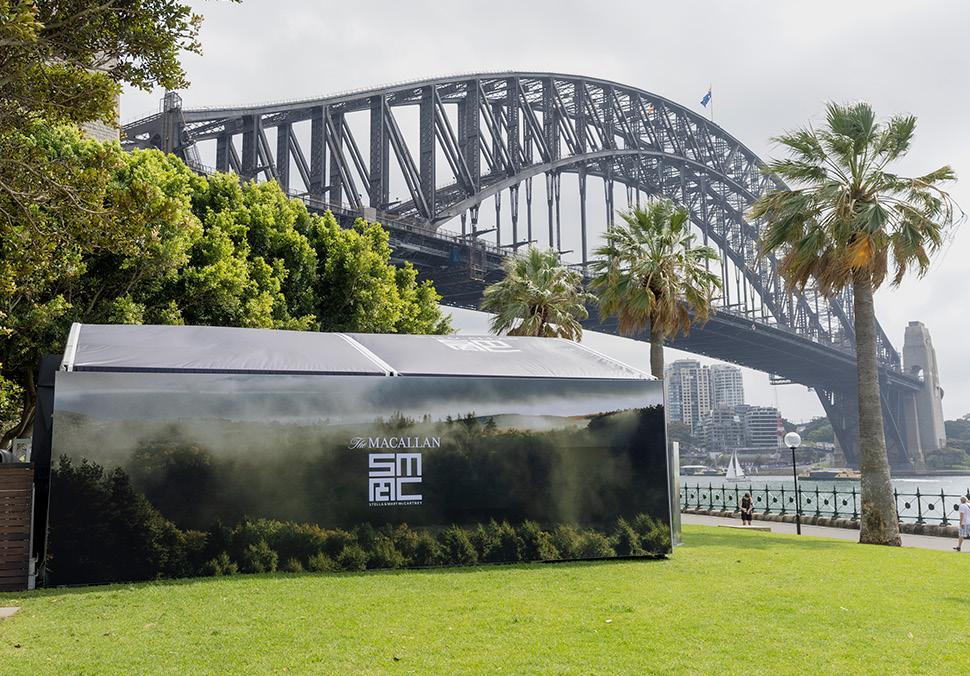



On Friday 8 March, Women of Australian Distilling hosted an International Women’s Day lunch at The Waratah in Darlinghurst, celebrating women’s achievements in the emerging Australian craft distilling industry.
Harriet Messenger from Husk Distillers led the program, which included speeches from four female pioneers who are helping to shape the industry.
Amanda Lampe, Director of Corporate Relations at Diageo Australia, shared her observations of the distilling industry, and her own journey through corporate affairs to the position she holds now.
Looking to this year’s International Women’s Day theme Inspire Inclusion, Hannah Brecknell, Venue and Events Manager at Manly Spirits, spoke about what inspires her as a woman, but she also took the time to remind the women in the audience to reflect on their own achievements.
Joining the lunch from Archie Rose was Spirit Blender Silvia Segato, whose belief in her own strengths formed the foundation of a vibrant career in liquor and hospitality that has taken her around the world.
Finally, Ed Svehla, Co-Owner of Banks & Solander Distillery, shared a glimpse into her strict religious upbringing, and her journey from a world where she was not allowed to consume alcohol, to founding a boutique micro distillery with her husband Marty, sharing her pride in all she has achieved along the way.
Guests at the event, which was open to all, enjoyed a set menu that showcased local producers and growers and native produce, paired with five cocktails using local spirits crafted by some of the women attending and curated by Andie Bulley, Creative Lead at The Waratah.
National Liquor News spoke to Matt Surman, owner of Black Rock Cellars, about how he provides a diverse and tailored selection of products for his customers.
Black Rocks Cellars is a fixture in Melbourne’s south-east, located within the Black Rock Village shopping precinct. For owner Matt Surman, Black Rock Cellars’ success is tied to its dedication to providing for the customer base and local community.
“We like being involved in the local community and adding to the village vibe that Black Rock Village shopping strip offers, and we are happy to support local fundraising for good causes,” he said.
Part of catering for the customer base has been providing the products that customers are looking for. Surman joked that staying on trend is as important in liquor as it is in the fashion industry.
“Gin was the big mover a couple of years ago. At Black Rock Cellars, we’re comfortable with being called a gin specialist, stocking over 200 different gins,” he said.
More recently, Surman has noticed an interest in lighter European red varietals and red blends, as well as a growing interest in rosé.
“We always have strong Champagne and sparkling sales, and whiskey and Scotch continue to be strong,” he added.
Another growing focus for Surman has been the online sphere, which he has found is increasingly important for liquor retail.
“E-commerce is a game changer and the future. We are fortunate to be a member of Liquor Marketing Group, which has invested heavily in this technology and was ready when we went through Covid,” he said.
However, Black Rock Cellars still prides itself on a “more instore” mentality.
“We are here to service and educate our customer base. I believe in providing a shopping experience, and offering great customer service from knowledgeable staff,” he said.

Part of customer education at Black Rock Cellars are the weekly in-store tastings, which are held in partnership with suppliers and producers.
“The tastings are predominantly wine, but we do change it up with local and imported craft beer and premium spirits. We hosted a Whiskey, Bourbon and Rum Masterclass with Coca-Cola Europacific Partners last month at a local café, Mantecado. We’re also planning a French wine dinner with Domaine Wine Shippers at True South restaurant in May,” Surman said.
One of the strengths of Black Rock Cellars is its ability to source the exact products that consumers are looking for.
“The benefit of being independent is being flexible. For example, if a customer spends a nice weekend away at a particular winery and loves that wine, we can normally source it for the customer straight away,” Surman said.
Surman also sells some of his own products in-store, including wine from his family winery, Wild Dog, and spirits that he and his brother distil at the Gippsland winery. While he recognises that it is important to provide a range of products for all budgets, Surman noted that Black Rock Cellars has had particular success with its rare and premium range, which provides a point of difference for the store.
Overall, Surman believes that independent liquor retailers are vital to maintaining a vibrant and diverse liquor industry.
“We need to keep the independent bottle shops and cellars strong. Without them you will have less representation of independent wineries, distillers, and breweries. There will be less choice and the big box stores will dictate what products to buy at what price.” ■
Do you have an upcoming launch, NPD, line extension or promotion? Then drive brand awareness. Support your sales team. Book a campaign. averaged unique users every month. 60,497*
